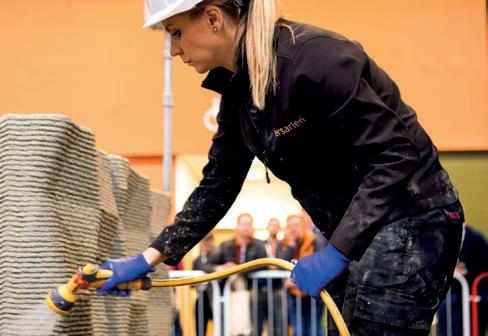
CONSTRUCTION MANAGEMENT BLETCHLEY PARK’S HERITAGE | INSIDE A MOCK HSE TRIAL | SALARY SURVEY RESULTS constructionmanagement.co.uk APRIL 2024 STEPPING UP ON COMPETENCE CONSTRUCTION’S BIGGEST BUILDING SAFETY CHALLENGE?





News
04 News in pictures
06 News: CIOB plans principal contractor competency register
07 News: MP praises inclusive PPE campaign in parliament
08 News CIOB People: Membership gives pay boost for 1 in 5
10 Data: Constructing data centres Can the UK remain a market leader?
Opinion
12 Caroline Gumble reflects on CIOB’s 190 years of excellence
13 Feedback: Readers’ views
Competency
14 Stepping up to new legislation Meeting dutyholder requirements
Heritage
20 Rosewood’s new Hyde Park views Restoring The Lancasters
26 Deciphering Bletchley Park Helping the site tell its story
Health and safety
32 Inside a mock HSE trial What happens after a fall
Global
36 Australia’s carbon campaigners Mecla’s Hudson Worsley explains
CPD
38 Approved Document O and noise Acoustics and excess heat
Legal
44 Contract Clinic: Third party rights Hill Dickinson LLP has the
CONSTRUCTION MANAGEMENT APRIL 2024 | 3 Contents n constructionmanagement.co.uk
04/24 Contents
Careers & Recruitment 46 ‘We need to organise differently’ Jacqui Glass FCIOB of The Bartlett Community 48 CIOB conservation conference 49 Hub visit to Chamberlain Square 50 Paterson is Building of the Year 51 Northampton reveals its history 54 Sustainable procurement webinar 55 Oxford’s new business powerhouse 56 Link up with CIOB Academy
What’s on over the next month Highlights of the CIOB calendar 46 20 26 10
answer
Diary dates 58


Fort Gilkicker redevelopment
A Grade II-listed 19th-century fort in Gosport, Hampshire, is being converted into 26 homes after falling into disrepair. Mabey Hire used 22 sensors to monitor site-wide vibration to ensure no damage was caused by the hydraulic breaker used to remove concrete.
Labour gets construction on the agenda
UK opposition leader Keir Starmer and shadow chancellor Rachel Reeves visited Mace’s Panorama project near St Paul’s Cathedral in London after the government announced the 2024 spring Budget.
4 | CONSTRUCTION MANAGEMENT APRIL 2024 n News constructionmanagement.co.uk


Carbon-neutral asphalt trial
Lancashire County Council has tested a new asphalt product by Aggregate Industries on the M65 slip road. The asphalt has a high percentage of recycled materials and requires less energy in its production due to its cold-lay manufacturing process. Foamix Eco can be manufactured and laid on site.
Neart na Gaoithe offshore wind farm
Belgium-based crane and heavy lifting company Sarens used self-propelled modular trailers to transport 54 wind turbine foundations – each weighing approximately 1,450 tonnes – for a new wind farm about 15km off the coast of Fife in Scotland.
Antarctic runway upgrade
BAM recently completed the resurfacing of the runway at the Rothera research station as part of the British Antarctic Survey’s Antarctic Infrastructure Modernisation Programme. The design was led by Ramboll.



Feline housing
Willmott Dixon built a house for a stray cat seen wandering the streets of Hitchin, Hertfordshire. The open-plan home, constructed over one level, has access to local amenities, with regular food deliveries and a constant supply of fresh water.
CONSTRUCTION MANAGEMENT APRIL 2024 | 5 News n constructionmanagement.co.uk
Professor Jacqui Glass tells CM how construction can transform itself (p46)
CIOB plans register for certified competent principal contractors
Institute’s Principal Contractor Competency Certification Scheme goes live later this month, following successful pilot. By

CIOB is to publish a principal contractor register to allow professionals to demonstrate they meet the competence requirements set out in the Building Safety Act and amended building regulations.
Candidates who have successfully completed the CIOB Principal Contractor Competency Certification Scheme (PCCCS) will be listed on the register. The scheme was developed by CIOB after the institute chaired the group which developed BSI’s PAS 8672 – Competence for Individual Principal Contractors.
Revised building control deadline ‘must be met’
Surveyors now have until 6 July to register with Building Safety Regulator
Will Mann
Initially run as a pilot, with a full rollout planned for later in April, the CIOB PCCCS is the first scheme of its kind in construction. Dan Harmer, a Tilbury Douglas project manager, was the first industry professional to pass (see interview, p18).
The scheme has been developed by Gerald Naylor, director of the Construction Wales Innovation Centre, who also wrote PAS 8671.
“Most professionals in our industry already have a high level of competence, and we’ve had a lot of interest in the CIOB scheme from big contractors who want to get in there first and show their clients they are taking competency seriously,” he said.
“But I think those who work at the smaller end of the industry have a lot to learn about the new PC duty holder role and they have got to learn it fairly quickly.”
Naylor added: “It makes sense to have a register that clients can rely on rather than having to individually assess every contractor they employ.”
The new deadline for building control surveyors to register with the Building Safety Regulator (BSR) “must be met”, CIOB has said.
Health & Safety Executive (HSE) director of building safety Philip White wrote to the industry on 14 March to say the registration deadline had been put back from 6 April to 6 July.
Local Authority Building Control (LABC) had warned of the potential collapse of the building control function in councils unless the deadline was postponed.
White said: “I understand those concerns and… the decision has been taken to implement a competence assessment extension
Last year’s amendments to the building regulations mean that, as of October 2023, anyone carrying out the new dutyholder roles of principal contractor (PC) and principal designer (PD) on construction projects must demonstrate their competence.
The changes mean that huge numbers of construction industry project managers will have to go through the competency certification process, warned Paul Nash, who chairs the CIOB’s quality advisory panel and sits on the Industry Safety Steering Group.
“We must be talking about 1,000s, possibly 10s of 1,000s,” he said. “In the CIOB membership alone, the vast majority of those are going to be project managers in contractors.
“But there can be no arguments, because we’re still seeing the consequences of poor building quality or building safety failures far too often,” he added. “We need to raise levels of competence across all building projects.” ●
Further details on the PCCCS, p14.
period for those meeting set criteria.”
CIOB’s director of policy, external affairs and research, Eddie Tuttle, said: “This revised deadline must be met and there is work to do in making that happen.”
The BSR estimates there are around 4,500 building control professionals in the UK.
6 | CONSTRUCTION MANAGEMENT APRIL 2024 n News constructionmanagement.co.uk
must be certified competent
PC dutyholders


MP praises CIOB’s inclusive PPE campaign in parliament
An MP has highlighted the role of CIOB’s #PPEthatfits campaign in improving the provision of inclusive PPE, reports Nadine Buddoo
Ministers have been urged to ensure personal protective equipment (PPE) is “designed with the female anatomy in mind”.
On 12 March, Labour MP Emma Hardy tabled the Personal Protective Equipment at Work (Protected Characteristics) Bill, which would require employers to ensure that PPE provided at work to people with certain protected characteristics is suitable for the wearer.
Speaking in the House of Commons, Hardy said: “The Chartered Institute of Building has launched a ‘PPE that fits’ campaign to drive awareness of the way in which ill-fitting PPE is affecting health and safety on site while also hampering the industry’s ability to attract and retain a more diverse workforce.”
Hardy also referenced recent campaigns and initiatives across the industry, including the Considerate Constructors Scheme’s decision to mandate women-specific PPE across all its sites.
She added: “I understand that this campaigning is indeed leading to change and that an increase in women’s PPE provision has been seen since it began, but workers deserve a guarantee that they will be protected.”
Improving current regulations
During the adjournment debate, Hardy explained that while the Personal Protective Equipment at Work Regulations (Amendment) 2022 were an important step forward when they came into force, they do not make specific mention of women.
“The world is finally waking up to the fact that women are not just smaller men, whether that is in the design of crash test dummies or in the creation, only three years ago, of the first anatomically accurate female 3D physiological model for medical students,” said Hardy.
“PPE needs to be designed with the female anatomy in mind. That also applies to the needs of others who are not catered for by a typical male body pattern.”
CIOB’s #PPEthatfits campaign was launched in July 2023. CIOB established a dedicated website, www.ppethatfits.com, with a global directory for buyers. ●
CIC appoints CIOB trustee as deputy chair

The Construction Industry Council has appointed CIOB fellow Ian Brant as the council’s new deputy chair. Brant has served on national and international committees for CIOB and is currently an elected trustee. He is expected to take on the role of chair, subject to CIC approval, after the current chair, Dr Wei Yang, steps down from her two-year term during CIC’s June 2025 council meeting.
CIOB chief executive Caroline Gumble welcomed Brant’s appointment: “Ian is a dedicated and very experienced professional who I know will do a great job. Congratulations, Ian, this is a well-deserved appointment.”
CIC’s chair, Dr Yang, said: “I look forward to working closely with Ian to enhance the profile of the construction industry, and to advance CIC’s strategic priorities in bringing built environment professions together for the public good.”
Brant said: “I am deeply honoured to have been elected as the new deputy chair for the CIC. The council is uniquely positioned to help the built environment professional bodies and its wider membership to liaise with government for the benefit of our industry and society.”
CONSTRUCTION MANAGEMENT APRIL 2024 | 7 News n constructionmanagement.co.uk
Emma Hardy MP: ‘I understand that this campaigning is indeed leading to change’
UK PARLIAMENT
Ian Brant FCIOB takes on leading industry role
constructionmanagement.co.uk
Construction’s new people development resource
Sign up for the weekly newsletter: ciobpeople.com/newsletter
CIOB membership gives pay boost for 1 in 5
Research shows that professional membership provides a solid footing for career progression, writes Nadine Buddoo
A new report reveals one in five CIOB members has earned more as a result of professional membership.
The inaugural Construction Salary and Market Trends Survey also shows that 69% of CIOB members earn more than the national average.
Respondents – including international CIOB members and non-members – revealed the average salary for construction professionals is £70,851. This is significantly higher than the national average of £34,963, according to figures published by the Office for National Statistics in November.
As well as providing insight into construction professionals’ views on their salary and career prospects, the Construction Salary and Market Trends Survey explores how membership with a professional body can support career progression.
When asked about how CIOB membership has made a difference to their career, 36% of respondents
explores how professional membership is a vital pillar for career progression and personal development
Ruth Kennedy-Green, CIOB
said it has given their skills and expertise more recognition.
Almost a quarter of respondents said that being affiliated with CIOB has allowed them to feel more connected to other professionals, as well as helping them to stand out more in the job marketplace.
According to 30.5% of those surveyed, membership has also helped them gain more professional knowledge, while 21.9% said it has helped their organisation win more business.
Commenting on the report, Ruth Kennedy-Green, acting director of membership at CIOB, said: “Construction management professionals face increased pressure as the wider industry tackles chronic skills shortages, employment legislation changes, and an urgent need to improve equality, diversity and inclusion.
“This report illustrates how these macro factors can have a direct impact on levels of career satisfaction. It also explores how professional membership is a vital pillar for career progression and personal development.”
The survey was conducted by Atom between 4 and 18 October 2023. It involved 879 respondents across a broad mix of sectors and job functions from all areas of construction management. ● Download the full report from www.ciobpeople.com.
How respondents say CIOB membership has benefited them
It has made me stand out in the job marketplace
My skills and expertise have gained more recognition
I have earned more money as a result
It has helped my organisation win more business
I have gained more knowledge
I feel more connected to other professionals


8 | CONSTRUCTION MANAGEMENT APRIL 2024 n News
This report
Salary breakdown of respondents Less than £30k £30k-£39.9k £40k-£49.9k £50k-£59.9k £60k-£69.9k £70k-£79.9k £80k-£89.9k £90k-£99.9k £100k-£150k £150k or more 20 15 10 5 0
0% 10% 20%30%40%50%


































7- 9 MA Y 2024 | EX CE L INCLUDES ENTRY TO: Offsite Show, Concrete Expo, & Grand Designs Live • 300+ EXHIBITORS • 6,000 PRODUCTS • NETWORKING EVENTS • 150+ HOURS OF CPD The UK’s Biggest Construction Event Official media partners A Media 10 event REGISTER FREE ukconstructionweek.com 7-9 MAY | EXCEL LONDON Sponsors # UKCW | @UK_CW in partnership with
Can UK construction keep up with data centre expansion?
London is among the leaders of the data centre market but capacity, skills and sustainability challenges could jeopardise its status, writes
Pablo Cristi Worm


From everyday technology to groundbreaking artificial intelligence (AI), our use of data is rapidly increasing. This growth is fuelling the expansion of the data centre industry. However, is the UK construction industry prepared to meet the demands this expansion brings?
Turner & Townsend’s Data Centre Cost Index 2023 found that London stands out as Europe’s
primary market for data centre expansion, estimated to have reached 1GW of operation capacity at the end of 2023.
Followed by Frankfurt, Amsterdam, Paris and Dublin, London ranks third globally, trailing only Beijing and North Virginia’s long-standing tech cluster. However, challenges regarding power grid capacity, land availability and shortages of skilled mechanical and electrical (M&E) specialised labour may hinder the pace of growth.
Clean energy challenges
Sustainability concerns about the use of carbon and energy demand also present significant obstacles. Electricity consumption from data centres, AI and the cryptocurrency sector is expected to double globally by 2026. By then, data centres alone will potentially consume over 1,000TWh of electricity worldwide – the equivalent of Japan’s total electricity consumption.
According to a study by the International Energy Agency, the
primary drivers of data centres’ electricity demands are the cooling systems and the servers themselves, with each typically accounting for 40% of the total consumption. The remaining 20% is consumed by the power supply system, storage devices and communication equipment.
Over time, regulation and technological advancements are expected to play crucial roles in addressing these challenges.
High-efficiency cooling systems have the potential to reduce electricity demand in data centres by 10%, while other research shows that a 20% reduction in consumption can be achieved through innovative water circulation techniques and the integration of low viscous fluids.
Along with the transition to hyperscale data centres, which typically include tens to hundreds of thousands of servers and associated infrastructure, these are key strategies the industry is adopting to reduce electricity demand and promote cleaner forms of power.
An optimistic future outlook
Beyond energy constraints, increased demand is making data centres a victim of their own success when it comes to more recognisable supply chain challenges.
The shortage of skilled M&E contractors, exacerbated by wider economic disruptions, is leading to increased labour costs and longer lead times for equipment and materials. Our data for Q1 2024 shows that some M&E components still show an average of two months of lead-in times, such as generators,
10 | CONSTRUCTION MANAGEMENT APRIL 2024 n Data constructionmanagement.co.uk
The shortage of skilled M&E contractors, exacerbated by wider economic disruptions, is leading to increased labour costs and longer lead times
chillers, rack mount units and transformers, among others.
Despite these obstacles, the demand for data centre services is not expected to slow. Driven by emerging digital technologies like blockchain and machine learning, several significant data centre projects are in the pipeline across the UK, indicating a healthy longterm outlook for the sector.
Projects such as the Google Data Centre in Hertfordshire, the Echelon LCY20 project and the Segro Park Iver project in Buckinghamshire, are among those expected to contribute to double-digit growth in the sector over the next two years.
To reduce risk and navigate this complex market, clients should explore alternative procurement models. Implementing proactive planning and adopting a portfolio management approach will effectively mitigate lead times by initiating procurement processes at early stages. Equally, moving away from traditional single general contractor (GC) procurement methods and towards major packages like shell and core or fit out, leveraging a mix of local and international GCs, can enhance project efficiency and flexibility.
Pablo Cristi Worm is a senior economist at Turner & Townsend.

SOURCE: BUILDING COST INFORMATION SERVICE

CONSTRUCTION MANAGEMENT APRIL 2024 | 11 Data n constructionmanagement.co.uk 8.0
pound per watt (£/W) cost of building a data centre in London
Average
M&E Cost Index,
Electricity consumption in the UK by sector (TWh) n Domestic n Industrial n Commercial and others BCIS M&E Cost Index Covid-19 Suez Canal obstruction Conflict in Ukraine Red Sea crisis 10 7.5 5 2.5 0 -2.5 2014 Q1 2015 Q2 2016 Q3 2017 Q4 2019 Q1 2020 Q2 2021 Q3 2022 Q4 2024 Q1 2013 Q3 2014 Q4 2016 Q1 2017 Q2 2018 Q3 2019 Q4 2021 Q1 2022 Q2 2023 Q3 90.0 67.5 45.0 22.5 0 SOURCE: DEPARTMENT FOR ENERGY SECURITY AND NET ZERO
BCIS
quarterly changes since 2014 (%)
 Caroline Gumble CIOB
Caroline Gumble CIOB
CIOB: 190 years of excellence in construction
Caroline Gumble reflects on CIOB’s achievements from its modest roots into the leading professional institute that is today

Last month we marked the 190th anniversary of the founding of CIOB, known back then as the Builders’ Society. Our story begins in a coffee house in London when a group of master builders got together for meetings to discuss the industry issues of the day. In understanding the origins of our humble beginnings, I realise how much the ethos and values that define who we are as an organisation have been present from the very beginning.
To offer one example, founding member Sir Samuel Morton Peto started his career as an apprentice and joiner and went on to play a part in creating some of London’s most iconic landmarks, including
Sir Samuel Morton Peto, one of CIOB’s founding members, was involved in the construction of some of London’s landmarks
Nelson’s Column and the Houses of Parliament. But his later working life was devoted to the public interest and public service by becoming an MP, a charity trustee and a mentor to young people in construction.
A few years later, in 1884, when the Builders’ Society was incorporated and became the Institute of Builders, our stated purpose was “to promote excellence in the construction of buildings and just and honourable practice in the conduct of business”. I like to think that we have held true to that – and plan to do so for years to come.
It’s important to remember one of the most significant milestones for CIOB: in 1980 we gained our royal
CIOB has had purpose and influence for nearly two centuries; it will continue after my tenure and be present for many more years to come
charter to become the Chartered Institute of Building. I believe this was hugely important in moving us forward as an organisation and further establishing our public interest remit.
While I don’t want to skip over our many achievements as an institute, it would be remiss of me not to acknowledge that our accomplishments are driven by our remarkable community of members. I want to thank all of them and CIOB staff – past and present – for their efforts in getting us to where we are today.
I recognise that so many of our global community of members have made invaluable contributions as volunteers, leaders, mentors and extraordinary examples of modern professionalism.
On a personal note, I regard my role as that of a custodian of this organisation. CIOB has had purpose and influence for nearly two centuries; it will continue after my tenure and be present for many more years to come, supporting, serving and setting standards for the built environment and those who create it.●
Caroline Gumble is CEO of CIOB.
12 | CONSTRUCTION MANAGEMENT APRIL 2024 n Opinion constructionmanagement.co.uk
LEO REYNOLDS
Feedback
CIOB People
A selection of readers’ comments about news and issues in the industry from across the CIOB community and social media
Greatest woman builder revealed Barbara Jones, Straw Works founder, was voted the most inspirational woman builder by readers of CIOB’s editorial titles
Claire Ridley ACR
Congratulations, Barbara.
I remember you from teaching strawbale building courses at Assington Mill when I taught weekend gilding courses there also. You kindly passed some furniture and gilding tools and materials on to me.
Jo Morandin
So well deserved, Barbara. You’ve inspired and empowered so many people through natural building. Glad that you’re receiving recognition!
Alliance for Sustainable Building Products
Well-deserved recognition of your ability to inspire and promote the use of sustainable building materials. We are delighted to have you as a long-standing member of ASBP and the Natural Fibre Insulation Group.
CM 12/03
Construction reluctant to hire people with criminal convictions
A new CIOB report found that just 25% of construction executives would hire people with a criminal conviction.
Mark Bailey
Barriers need to be broken down with project commissioners first. Working on local authority frameworks, we have received significant resistance to having any ex-offenders on their projects.
CM March
‘This AI research is at the cutting edge of current industry thinking’ University of Reading Professor Tabarak Ballal FCIOB shared insights on advancing research and

Rene Dalmeijer
Barbara, you fully deserve recognition for your work, specifically for empowering and forwarding the role of women in building.
knowledge in artificial intelligence applications in construction.
Trevor Mpatsi MCIOB MRICS PrCPM
Tabarak Ballal is spot on: without a relationship between academia and industry, the advancement of the built environment will continue to be slow, inept and ignored in some quarters. With a collaborative approach, our industry will excel. But it requires both parties to be willing to listen and learn from each other.
CM March
‘Good health and safety comes from operational excellence’
David Bucksley, health, safety and wellbeing director at Sir Robert McAlpine, told CM how he became involved in this area and what are the greatest misconceptions around his work.
Events such as Grenfell could not occur in an operational excellence environment
Andy Brown
Gareth Terry CMIOSH MIIRSM
Do construction organisations consider adding meaningful value and demonstrate leadership in creating psychologically safe environments for the workforce to thrive with autonomy? Or rather, transactional health and safety management, with rigidity to appease those short-term contractual obligations?
Health and safety performance is very much defined by those pre-determined lagging indicators, so often counterintuitive and counterproductive in creating high-performing environments that consider people at the centre of ‘everything’ they do.
Andy Brown
A simple message with such broad application beyond workplace safety. Events such as Grenfell could not occur in an operational excellence environment/ mindset. The key underlying challenge is: what creates operational excellence? I would suggest all professional bodies have a part to play in creating it.
BIMplus 22/02
Is the Information Delivery Specification the future?
John Ford
It’s undoubtedly the future, one that will require significant learning and adaptation. However, it’s unfortunate that it will likely undergo a prolonged period of what can be termed as ‘BIM abuse,’ akin to many other information requirement-based specifications, often presented in extensive written texts exceeding 60 pages based on templates. This misuse will inevitably impede investment in learning and education initiatives.
It’s crucial to note that this issue isn’t inherently caused by Information Delivery Specification or BuildingSMART but rather a consequence of how they are implemented.
Share your views on the latest industry issues by posting comments online at www.constructionmanagement.co.uk or by emailing the editor at construction-management@ atompublishing.co.uk
CONSTRUCTION MANAGEMENT APRIL 2024 | 13 Opinion n constructionmanagement.co.uk
Stepping up on competency
Demonstrating competency is now a legal requirement for the new dutyholder roles of the Building Safety Act. As CIOB launches its Principal Contractor Competency Certification Scheme, Will Mann looks at whether the industry is ready for the changes
People outside the industry still have this attitude that construction is full of cowboy builders. But we don’t all deserve to be tarred with that brush. There are good people out there and they genuinely want to do the right thing. And this CIOB competency scheme will recognise that – it will certify those people who are doing the right thing.”
Tilbury Douglas project manager Dan Harmer is the first person to complete – successfully – the new CIOB Principal Contractor Competence Certification Scheme (PCCCS) (see p18).
Initially run as a pilot, with a full rollout planned for later in April, it is the first scheme of its kind in construction.
Its arrival could not be more timely. As of October 2023, anyone carrying out the new dutyholder roles of principal contractor (PC) and principal designer (PD) on construction projects must demonstrate their competence. This requirement, introduced in last year’s amendments to the Building
Regulations, will take on sharper focus in July when building control becomes formally regulated.
It means a major step up on competence for construction project managers, although there are concerns that many – and we are talking big numbers – are not aware of their new dutyholder responsibilities.
Paul Nash FCIOB, who chairs CIOB’s quality advisory panel and sits on the Industry Safety Steering Group, says the changes are not before time.
“Unfortunately, we’re still seeing the consequences of poor building quality or building safety failures far too often, aren’t we?” he says. “The fire in Valencia and the balcony collapse in Brighton before Christmas are two examples.
“We heard in the Grenfell Inquiry about people acting beyond their level of competence, such as an architect who had never worked on a high-rise building before, and Dame Judith Hackitt highlighted competence concerns in her Independent Review of Building Regulations and Fire Safety.”
Tier 1 contractors have been asking for a while: how do we demonstrate competence? And CIOB’s certification scheme provides the answer
Paul Nash, CIOB quality panel
Since then, “the industry has been on a journey”, Nash says. This has included the Construction Industry Council’s competency working groups, publication of the Competence Steering Group reports, a new competence framework for project managers (developed by CIOB), and the new BSI PAS 8672 standard for PCs. Now we have CIOB’s PCCCS.
“I’ve spoken to tier 1 contractors, who have been asking for a while this question: how do we demonstrate our competence?”
Nash says. “And CIOB’s certification scheme provides the answer.”
To be eligible for the PCCCS, which involves a written application and a rigorous peer review, candidates must be a member of a professional body and have three years of experience. It is offered in two categories: A, for all buildings excluding higher-risk buildings, and B, which also includes higher-risk buildings.
The scheme has been developed by Gerald Naylor FCIOB, director of the Construction Wales Innovation Centre, who also wrote PAS 8671.
14 | CONSTRUCTION MANAGEMENT APRIL 2024 n Competency constructionmanagement.co.uk

Most construction professionals have a high level of competence – but I think those at the smaller end of the industry have a lot to learn and fairly quickly
Gerald Naylor, PAS 8671
author
“Most professionals in our industry already have a high level of competence,” he says. “They carry out due diligence. They have the right cultural mindset. The people who provided feedback during the creation of PAS 8671 and for the PCCCS are embracing change, they want to see a level playing field.
“We’ve had a lot of interest in the CIOB scheme from big contractors who want to get in there first and show their clients they are taking competency seriously.
“But I think those who work at the smaller end of the industry, who don’t have big organisations supporting them, they will have a lot to learn about the new PC duty holder role and they have got to learn it fairly quickly.
“The biggest change is a cultural one. We have to be more mindful of what we’re producing. It should not be based on just price and speed, but on quality and on safety. Not just safety for the construction workers, but safety for the building occupants.”
Naylor acknowledges that the dutyholder roles of PC and PD have caused confusion because they share the same terminology as the CDM Regulations. “Some people think it is a simple extension of CDM, which it isn’t,” he notes.
But he hopes understanding about the dutyholder responsibilities will grow quickly now it is enshrined in law.
CONSTRUCTION MANAGEMENT APRIL 2024 | 15 Competency n constructionmanagement.co.uk

It makes sense to have a register that clients can rely on rather than having to individually assess every contractor they employ
Gerald Naylor, PAS 8671 author
“The pressure will build from legislators and auditors,” he says. “There will be peer pressure as big contractors put their project managers through competency certification. The insurance industry may also respond to this issue of competency now that PCs need to be accountable under the Building Safety Act.”
Key to driving PC competence certification will be clients, thinks Nash. “There are a lot of additional duties on clients here and if I’m talking to contractors or quantity surveyors or consultants or architects, I say please, please, please make sure your clients are aware of their duties under the Building Safety Act,” he says.
“It’s not like CDM, where a client could appoint a principal designer on the CDM, and they’ve discharged their duties. There are much more onerous requirements on clients for all buildings, not just higher-risk buildings.
“Clients will need to demonstrate and satisfy themselves that the
people they are appointing as PCs and PDs are competent.”
Would it therefore make sense to have a register of PCs who are certified as competent, to help guide clients? Building control surveyors must be registered with the Building Safety Regulator (BSR) from next month. RIBA has set up a register for architects who have completed its PD certification scheme and the Association for Project Safety (APS) has its own PD register for non-architects.
The good news is that CIOB is planning to create a register for PCs who successfully complete the competency scheme.
“It makes sense to have a register that clients can rely on rather than having to individually assess every contractor they employ,” Naylor says.
Nash agrees: “What the client can then do is say, ‘I’ve taken all reasonable proportionate steps to establish that the person I’m appointing to this function is competent. And the way I’ve done that is I’ve gone to that person’s professional body’.”
Meanwhile, huge numbers of construction industry project managers will have to go through the competency certification process – and as soon as possible.
“We must be talking about 1,000s, possibly 10s of 1,000s,” says Nash. “In the CIOB membership alone, the vast majority of those are going to be project managers in contractors.
“But there can be no arguments. This process started with one tragic event – the Grenfell Tower fire – but let’s not kid ourselves, this isn’t restricted to high-rise buildings. We saw it on Edinburgh schools in 2016, we’ve seen it on other projects since. We need to raise levels of competence across all building projects.” l

CIOB Principal Contractor Competency Certification Scheme
l Developed by CIOB after the institute chaired the group which developed PAS 8672 – Competence for Individual Principal Contractors, based on the recommendations and core competence criteria set out in BSI Flex 8670.
l The CIOB Principal Contractor Competency Certification Scheme is a competence-based validation of a person’s skills to carry out the new dutyholder role of principal contractor under the building safety legislation and does not relate to the historic role under CDM regulations.
l The scheme has two categories: one
covers all buildings excluding higher-risk buildings and the other is for all buildings.
l Candidates complete a written competencebased application form and then attend a peer review.
l The scheme is renewable every five years.
l Candidates need to be a member of CIOB or another professional body, that holds them to a code of ethics, and have three years of experience.
l The CIOB PCCCS is the only one of its kind in the market.
Further information: www.ciob.org.
16 | CONSTRUCTION MANAGEMENT APRIL 2024 n Competency constructionmanagement.co.uk

‘What I learned from CIOB’s PC competency scheme’
Tilbury Douglas project manager
Dan Harmer is the first candidate to go through the CIOB Principal Contractor Competency Certification Scheme. He tells CM why he and his company signed up

Why did you and Tilbury Douglas put yourself forward?
There has been a step change in the industry, more emphasis on competence and quality. I’m seeing that especially with fire safety – with fire cavity barriers, making sure you’ve got all the right testing certificates, having the right materials in the right place and installed by people who are approved to install them.
As a tier 1 contractor, we must make sure we select the right people. People outside the industry still have this attitude that construction is full of cowboy builders. But we don’t all deserve to be tarred with that brush. There are good people out there and they genuinely want to do the right thing. And this CIOB competency scheme will recognise that – it will certify those people who are doing the right thing.
Tell us how you were assessed. Firstly you are assessed on your competence to take the scheme. It is very much experience-led. I’ve gone through the higher-risk buildings category (category B) because I’ve worked on projects which fell under that category: high-rise residential buildings and the NEC Nightingale Hospital, a fast-paced project.
The assessment is in two sections: a written section and an interview.
One of the key things is understanding how the Building Safety Act impacts us. I had to write a piece on my understanding of the legal duties of a principal contractor and how I would execute them.
The interview was run by two industry peers who asked probing questions about my written submission. I did a presentation, with a series of photographs. One showed a toolbox talk I was giving to a site of 150 people, because I wanted to
I think when you consider how health and safety attitudes have changed over the last two decades, we are going to see the same with competency. This is just the start of the curve
Dan Harmer, Tilbury Douglas
demonstrate my understanding of how important quality is.
I also included photos where I was overseeing high-risk activities, such as a series of crane lifts and a project where we had to tunnel under the Hagley Road in Birmingham. I had to explain what we were trying to do, why I selected those individuals, how I managed that whole process and what was the outcome.
What message would you give other project managers about the CIOB PC competency scheme?
The Building Safety Act 2022 explains the requirements for principal contractors and what this scheme does is give you the ability to demonstrate that you comply.
I think when you consider how health and safety attitudes have changed over the last two decades, we are going to see the same with competency. This is just the start of the curve. At the moment, it’s just people like myself and colleagues going forward for this scheme, but I think it will become a requirement for everybody working in that PC role and – as with health and safety – you will have a competence card. It doesn’t take years to be certified. If you knuckle down, you can potentially get this sorted within two to three months. But you do need the experience to take the scheme in the first place. ●
18 | CONSTRUCTION MANAGEMENT APRIL 2024 n Competency constructionmanagement.co.uk
SKY HIGH CAMERA LTD

Heritage heroics on Hyde Park
Since July 2019, at a historic residential building overlooking London’s Hyde Park, CIOB chartered company member and heritage specialist Rosewood has been working on a complex facade restoration project. CM reports
The Lancasters sits in one of London’s most exclusive postcodes.
Grade II-listed and built between 1856 and 1865, this French neoclassical style terrace of 15 ambassadorial residences in W2 has spectacular views across Hyde Park, with elevations on Lancaster Gate, Leinster Terrace and the Bayswater Road.
The terrace underwent significant redevelopment over a decade ago, with the internal floors and walls demolished and a new concreteframed replacement structure built in their place, but the French neoclassical facade was retained. More recently, heritage specialist and CIOB chartered company member Rosewood has been working on what is the largest stucco facade restoration project on a single residential block in the UK.
“It demonstrates our ability to work on large-scale, complex heritage projects,” says Nick Austen-Smith MCIOB, contracts director at Rosewood.
Project overview
l The Lancasters, Hyde Park
l Principal contractor: Rosewood
l Restorer and stone fixer: Rosewood
l Joinery: Rosewood
l Decorations: Rosewood
l Structural engineer: Hockley & Dawson
l Specialist fixing engineer: Harrison Goldman
l Contract administrator: EBW Consultants
l Project manager: Arambol
The project began in 2019, just before the Covid-19 pandemic. The scheme includes stripping of the lead-based paint, structural brickwork and the replacement of failed structural ties, stucco restoration to the entire fabric of the buildings, joinery and decoration. The programme was due to be completed within two years, but this was extended due to the volume of works uncovered.
“We have a collaborative and open-book working policy, involving Rosewood, the client, project team and stakeholders, and as issues of the past emerged the programme was extended to a fifth year on site,” says Austen-Smith. “We are seeking to complete by August 2024.”
Rosewood commenced with the removal of the lead-based paint on the facade, using specialist water and media-based cleaning methodology. This is a complex process which requires careful disposal of the lead paint. In 2018, the contractor created 12 cleaning samples for the Westminster Council
We hand restored and re-ran, in lime render, the entire stucco facade to match the original Victorian build Nick Austen-Smith, Rosewood
conservation officer and the client to demonstrate that only the paint would be removed and the stucco facade remain in its original detail.
“The different encapsulation methods ensured that no paint escaped the confines of the scaffold,” explains Austen-Smith. “These included a shrink wrap to the scaffold, negative internal air pressures so the fabric was not affected and vacuum systems on the scaffold to draw all debris into waste units ready for collection.”
On completion of the paint removal, Rosewood carried out a survey to all the stucco – with any failed stucco removed – followed by surveys of the inner structural brickwork, once exposed.
20 | CONSTRUCTION MANAGEMENT APRIL 2024 n Heritage constructionmanagement.co.uk
The Grade II listed Lancasters building has views across Hyde Park

CONSTRUCTION MANAGEMENT APRIL 2024 | 21 Heritage n constructionmanagement.co.uk

“These surveys allowed us to map out each and every repair to the structure of the building and its highly decorative facade,” says Austen-Smith.
“The like-for-like repairs and replacement work involved classical methodology, including the use of horse moulds to re-run the cornices and window surrounds, the removal of modern concrete lintels to be replaced with classical London stock brick arches as per the original design,” Austen-Smith says. “This allows the building to move as it was intended to.
“We also fitted new detailing where there was complete failure
of the capitals, window pediments and arches and the decorative lion heads.”
In tandem with the stucco works, Rosewood’s team structurally rebuilt much of the inner brickwork skin of the structure, while installing over 1,500 stainless steel ties to maintain the connection between the original facade and the modern concrete frame behind.
“We then hand-restored and re-ran, in lime render, the entire stucco facade to match the original Victorian build,” says Austen-Smith.
“Finally, we completed the restoration with a mineral-based paint, spray-applied for the finest of finishes.”
We fitted new detailing where there was complete failure of the capitals Nick AustenSmith, Rosewood

22 | CONSTRUCTION MANAGEMENT APRIL 2024 n Heritage constructionmanagement.co.uk
Horse moulds were used to re-run the ornate lime render


The workforce on the project has ranged from 35 up to 125 on site each day. Rosewood has overseen a stringent quality assurance scheme, says Austen-Smith.
“Each trade has their respective foreperson to oversee the quality assurance which feeds up to the project manager and senior management team prior to handing over to the client,” he explains. “At
Rosewood we have an in-house clerk of works, which is a little old-fashioned but ensures quality is always at the forefront of what we do as a principal contractor.”
However, the greatest challenge for Rosewood on the project has been sourcing skilled labour.
“So that we can continue our strong heritage of apprenticeships, we have been training throughout our four-and-a-half years on site and will continue to do so,” Austen-Smith explains.
Eddie McFadden, Rosewood logistics director, has headed up the apprenticeship scheme. He notes: “During the project, eight restoration apprenticeships have been completed plus two NVQ7 management qualifications, which is testament to our investment in the future of Rosewood and the heritage sector.”
The ongoing training of skilled labour is “paramount” to Rosewood, adds McFadden and, as the works on The Lancasters come to a close,
During the project, eight restoration apprenticeships have been completed plus two NVQ7 management qualifications
Eddie McFadden, Rosewood
all of the team will move on to other projects in the company’s portfolio.
Rosewood managing director John O’Sullivan adds: “I could not be prouder of the company’s effort throughout this project. it is testament to all involved and the quality of the works produced demonstrates our expertise as a principal contractor.”
As the project developed, the complexity and diverse challenges allowed Austen-Smith and the team to showcase the works, organising 12 walking tours of The Lancasters for surveyors and engineers, which will help Rosewood build on current and future relationships within the heritage market. ●

24 | CONSTRUCTION MANAGEMENT APRIL 2024 n Heritage constructionmanagement.co.uk
The likefor-like repairs involved classical methodology (above and below)

The enigma of estate management at Bletchley Park
Home of World War Two’s codebreakers, Bletchley Park is constantly looking for new ways to tell its stories. Kristina Smith talks to head of site works Phil Atkins about the conservation and new build projects on the famous estate

n Heritage constructionmanagement.co.uk
26 | CONSTRUCTION MANAGEMENT APRIL 2024
When the board of trustees at Bletchley Park advertised for a head of site works in late 2015, there can’t have been many who could have fitted the bill. They were looking for someone who could manage the FM and maintenance team, the landscaping team of salaried staff and volunteers, and someone who could project manage an ongoing programme of capital works. They even wanted the candidate to have CAD skills.
Step forward Phil Atkins, whose unusual career path now seems almost tailor-made for his job at the former workplace of codebreakers such as Alan Turing during the Second World War. A graduate in rural resource management, it was a part-time job at a self-storage store while studying that led him to work for multiple firms in that sector, which he followed with stints at contractor Rok and offsite building manufacturer Terrapin and then various facilities management roles.
Atkins recalls coming across the job advert on Bletchley Park’s Facebook page, which he was following as a local resident and visitor. “I thought ‘that’s quite a diverse job description’. I could join the dots between my experience and the job here,” says Atkins. “Then I did everything in my power to make sure I got the job.” The day of his interview, he was offered the role.
Almost eight years on, Atkins is proud to have successfully delivered

Bletchley Park head of site works
Phil Atkins in the Fellowship Auditorium
Bletchley Park was made famous by its Bombe decoding machine. A replica is on show
Bletchley Park’s most recent capital works programme: a £14m, threephase affair which has seen wartime buildings at the heart of the site opened to the public for the first time. They have been repurposed as exhibition spaces, another turned into a collection and archive store and the creation of a learning centre including the construction of a beautiful new auditorium.
Two local contractors have delivered the works, Neville Special Projects and Edgar Taylor Construction, both of which are headed up by MCIOBs: Simon Last and James Taylor respectively.
Getting the job right goes beyond personal satisfaction for Atkins and his
We all have an awful lot of pride in working here. It is like a family. People become wedded to the conservation and preservation
Phil Atkins, Bletchley Park Trust
colleagues. It is about ensuring that the Bletchley Park story continues to be told to future generations through the way the buildings are cared for and repurposed. “We all have an awful lot of pride in working here,” he explains. “It is like a family. People become wedded to the conservation and the preservation.”
A fight for survival
Walking around Bletchley Park, the link between the work done here during the Second World War and today’s big-data opportunities and threats are striking. It’s hard to believe that this place’s future as a museum has been in jeopardy.
Back in 1990, having been home to a teacher-training college and a headquarters for the local GPO, there were plans to demolish the site and redevelop it for housing and a supermarket. The Bletchley Park Trust was formed in 1992 in response. Then in 2011 the Trust was able to secure a £4.6m grant from the National Lottery. Along with the support of a variety of a wide range of trusts, companies and individual donors, and the work of many people, this was a major step forward in securing the future of the site.
The Trust was able to restore and open the original wartime codebreaking huts, and restore and convert one of the wartime blocks into its visitor centre. In 2014, the same year that the film The Imitation Game, starring Benedict Cumberbatch as Alan Turing,
Heritage n constructionmanagement.co.uk
CONSTRUCTION MANAGEMENT APRIL 2024 | 27

was released, the revived Bletchley Park was opened by the then HRH the Duchess of Cambridge, whose grandmother worked here during the war along with her twin sister.
Since 2016 when Atkins arrived on site, there has been a series of projects, opening up more of the site to visitors.
“Project management was one of the key skills that the Trust wanted when they employed me,” says Atkins. “As an in-house project manager, I am a lot closer to the coal face and constantly talking to the contractors. I am in the thick of it most of the time, in my hi-vis and covered in dust. I also get to see how the build evolves and to
understand how it’s assembled and have the chance to influence fixtures and fittings.”
The first project Atkins oversaw involved modifications to Hut 11A to house an exhibition about the Bombe – invented to speed up the breaking of the Enigma cipher – which required an upgrade of the building including the discreet introduction of air-handling plant.
Next came the refurbishment of the Teleprinter Building to house the D-Day: Interception, Intelligence, Invasion exhibition. Opening in April 2019, shortly ahead of the 75-year anniversary of the D-Day Landings, this exhibition tells the human story behind the landings.
Each of the three phases of the latest tranche of work was tendered separately, and went to local contractors, which Atkins prefers for sustainability reasons. The first two were awarded to Neville Special Projects while the third went to Edgar Taylor Construction.
The first phase saw the redevelopment of Block A to create two exhibition spaces. The first now houses Bletchley Park’s The Intelligence Factory exhibition, which uses personal stories and exhibits to explain how a mindboggling 9,000-person workforce was deployed. The second provides a controlled environment for visiting exhibitions and is currently home
28 | CONSTRUCTION MANAGEMENT APRIL 2024 n Heritage constructionmanagement.co.uk
Block E is a refurbished wartime building incorporating the Learning Centre
In historic buildings you can negotiate your way out of some of the accessibility rules, but we don’t want our visitors to find they can’t access parts of the site
Phil Atkins, Bletchley Park Trust
to The Art of Data: Making sense of the world, which showcases visualisations of data then and now.
Walking around Block A, Atkins points out some of the challenges in preserving the original aesthetic while respecting modern building control requirements. For instance, all the cabling for the electrics is surface mounted rather than chased in, an alien concept to the electricians.
Achieving adequate fire protection was another conundrum since the steel columns of the building are encased in chamfered concrete.
Although the blocks were erected fast, to house the growing workforce of codebreakers, they were robustly constructed, says Atkins. At the time when the site was chosen to be the Government Code & Cypher School (GCCS), a developer was planning to build housing there and it was he who went on to construct the blocks.
A major hurdle for any works at Bletchley is how to maintain the character of the buildings while making them accessible.
“We have to do it as subtly as we can. Our aspiration is to achieve BS 8300 (Design of an accessible and inclusive built environment), which is very difficult, but we certainly push further than Document M requires,” says Atkins.
“In historic buildings you can negotiate your way out of some of the accessibility rules, but that’s not desirable for us. We don’t want our visitors to find they can’t access
parts of the site or have to call up to find out which bits are accessible.”
In Block A, Atkins, with advice from the Centre for Accessible Environments, decided to cut wide doorways between rooms to allow people using wheelchairs or walking aids to move freely. As Atkins indicates one of these doorways, a visitor using two sticks walks through it, underlining the sense of the decision.
The second phase of the programme saw the refurbishment of an extension to the wartime Teleprinter Building. As well as housing Bletchley Park’s 420,000 artefacts and documents, it has a working area where volunteers are currently digitising the entire archive.
“This was quite a quirky building,” explains Atkins. “They built it as a single storey then, as they topped it out, they decided it was not big enough, so they added another storey. It has 13-inch-thick walls; the idea was to protect the machines.”
Now, the whole building is fire protected for two hours, with one room equipped with an active fire suppression where nitrogen replaces some of the oxygen to create a hypoxic environment in which a fire cannot start.
Learning from history
The final – and most costly – phase of the work was the creation of the Learning Centre. Unlike the other two buildings, Block E had been in
Some 75% of the Bletchley Park wartime workforce were women

Bletchley Park history
l The Victorian-era manor house dates from 1883.
l The 23ha site was acquired in 1938 and developed for use by the Government Code and Cypher School (GC&CS) during World War Two.
l The GC&CS team of codebreakers, including Alan Turing, regularly cracked the secret communications of Nazi Germany during the war, most notably the Enigma and Lorenz ciphers.
l Some 75% of the Bletchley Park wartime workforce were women.
l After the war, the site was used by various
government agencies, but was at risk of being sold for housing development in 1990, until Milton Keynes Council made it a conservation area.
l The Bletchley Park Trust was set up in 1992 to maintain the site as a museum.
l Visitor attractions include interpretive exhibits, a working replica Bombe machine, and huts rebuilt to appear as they did during wartime.
l Bletchley Park also houses learning facilities and the National Museum of Computing.
CONSTRUCTION MANAGEMENT APRIL 2024 | 29 Heritage n constructionmanagement.co.uk
Women workers in Block E at Bletchley Park during the Second World War
75
use, with space let out on a serviced office basis. It also incorporates a brand-new building to house the 250-seat lecture theatre.
There are eight classrooms within the Learning Centre, each with a different colour scheme. The buildings have been taken back to brick and block, with acoustic rafts to absorb noise. In a larger room, designed for events and adult learning, there is a beautiful modern large-plank parquet floor.
Local contractor Edgar Taylor, based in Buckingham, delivered phase three of the latest Bletchley Park capital works programme – the Learning Centre and new auditorium.
“Most of our work is repeat relationships and the connection with Bletchley Park came through our successful completion of the Story Museum project in Oxford, which was particularly challenging,” says managing director James Taylor MCIOB.
Most of the challenges on this project were linked to the repurposing of the existing

The connection with Bletchley Park came through our successful completion of the Story Museum project in Oxford James Taylor, Edgar Taylor Construction

The Fellowship Auditorium is a purpose-built event space
buildings, according to Edgar Taylor operations director Bryan Doyle. An early discovery that there was more asbestos than an initial survey had predicted triggered an extensive value engineering exercise, to get the budget back on track.
Then, when fitting out the classrooms and communal spaces the contractor had to work closely and iteratively with architect Giles Quarme to aesthetically coordinate the setting out of the exposed black service routes with the extensive acoustic features and lighting. The architect wanted the original fabric to remain very visible, which meant that adding an internal acoustic skin was not an option.
The end result is testament to the teamwork and perseverance in getting things just so.
“I am very proud of the quality achieved and that the auditorium looks so much like the original visualisations despite all the VE and financial constraints,” says Doyle.
“I think the team has sympathetically repurposed this local building which is of such significant historical importance.”
Next door is the Fellowship Auditorium – named to honour funding support from the Post Office Remembrance Fellowship – which can also be accessed via a reception area which during the war housed two emergency generators.
The Fellowship Auditorium is the last stop on our tour and is suitably jaw-dropping, with beautiful finishes and featuring timber on the floors, walls and balustrades. “I had been looking at it in Revit for such a long time. When it came together in the finishes, it was mind-blowing,” says Atkins.
The Learning Centre was completed before the international AI Safety Summit was held at Bletchley in November 2023 – a reminder of Bletchley Park’s relevance in the modern world and another way to attract and engage visitors. ●
30 | CONSTRUCTION MANAGEMENT APRIL 2024 n Heritage constructionmanagement.co.uk


Anatomy of a fall: inside a mock HSE trial
If there’s an accident on your site and the HSE investigates, what happens next? A ‘mock trial’ shows how proceedings work in a health and safety prosecution. Cristina Lago sits in
CM was in court recently. Only, in this case, the court was a bright room of a riverside London office, those sitting in the dock were lawyers with impressive acting skills, and the jury was made up of curious guests keen to understand what happens during a prosecution following a serious accident at a construction site.
During this ‘mock trial’, the health and safety team at law firm Fieldfisher recreated a prosecution brought forward by the Health and Safety Executive (HSE). Although the company and witnesses involved were all fictional – played by actual lawyers – the case echoed one of the many construction prosecutions brought by HSE. The jury was made up of the guests in attendance – split into three groups to see if they would all reach the same verdict.
The prosecution barrister sent ‘the jury’ a clear message during his opening speech: these proceedings were not just about an accident but about determining if the company accused of health and safety breaches did everything that was at hand to reduce risk.
“Scaffolding is a dangerous business, and the prosecution claims that the company should have taken steps to mitigate risks,” he gravely told the jury.
32 | CONSTRUCTION MANAGEMENT APRIL 2024 n Health & Safety constructionmanagement.co.uk
An agency worker hired by fictitious scaffolding company Rud Hill Ltd suffered multiple injuries to the head, spine and one leg following a fall from height
The circumstances leading to the accident
The court was given the background to the accident. An agency worker hired by fictitious scaffolding company Rud Hill Ltd suffered multiple injuries to the head, spine and one leg following a fall from height at a project in Essex. When the senior projects manager rushed to the scene, he found out that the worker had not been using a security lanyard when the incident happened.
Although Rud Hill employed a team of professional scaffolders trained to varying levels in the Construction Industry Scaffolders Record Scheme, an increase in service demand since the pandemic led the company to hire additional agency workers.
However, Rud Hill had been slow to expand its back-office function and roll out recruitment and training programmes to match its increased hiring strategy. It had also not reviewed its health and safety policies and procedures for some time.
While the senior projects manager was on leave, the managing director tasked a less experienced employee to hire agency workers for the Essex job, who were given a very brief induction to the project and site. They did not receive proper training and no risk assessments were carried out.
When the senior projects manager returned from leave days before the accident, he found that his colleague who had hired the agency
workers had not yet completed risk assessments. The senior projects manager raised concerns about this with the MD, who told him he would look into the issue – but then the accident happened.
An investigation by the police concluded that the accident was caused by a failure of Rud Hill to provide appropriate equipment to the agency worker. It also found that there was an overall lack of health and safety systems in place to protect employees, contractors and other third parties. As a result, the police reported the accident to the HSE.
Following the HSE inspector’s investigation, the HSE informed Rud Hill that it would be prosecuted and the matter proceeded to trial.
The charges
Rud Hill was charged with breaching s.3(1) Health and Safety at Work Act 1974 – failing to protect non-employees from health and safety risks from its undertaking.
The mock trial’s time constraints did not allow it to incorporate other charges. However, in this scenario, there was also the possibility of the following charges:
l s.2(1) Health and Safety at Work Act 1974 – failing to protect employees from health and safety risks (in relation to the agency failing to protect the agency worker);
l s.37 Health and Safety at Work Act 1974 – provides for the liability

of a director, manager, secretary or similar officer of a body corporate where it is shown that an offence was committed by the company and this was due to the consent or connivance of, or attributable to any neglect on the part of the director or manager, etc.
Evidence and cross-examination
The prosecution’s opening speech was followed by its witnesses’ evidence and cross-examination, including the agency worker who suffered the accident, Rud Hill’s managing director, Rud Hill’s senior projects manager, a company employee and the HSE inspector who carried out the investigation.
The first witness to be called was the agency worker, who gave evidence as to what happened in the lead-up to the accident. Having suffered life-changing injuries didn’t spare him from being ferociously grilled by the defence’s counsel.
“There was confusion about what we should or should not be wearing in terms of safety equipment on site,” the agency worker said.
CONSTRUCTION MANAGEMENT APRIL 2024 | 33 Health & Safety n constructionmanagement.co.uk
The prosecution counsel (right) asks the agency worker about the accident he had at the Rud Hill site
The defence barrister tried to persuade the jury that Rud Hill had done everything it could to prevent the accident and, as such, it should be declared not guilty
Although he admitted that he often made his own judgement about whether a lanyard was needed, he said he wasn’t provided with one on the day of the accident anyway. He also explained to the prosecution that on his first day he received a short induction and tour of the site but could not remember getting any training or being told about “safe systems of work”.
He accepted that his memory was “quite hazy” as a result of his injuries, a fact that the defence highlighted in his cross-examination.
After the accident, the agency worker had to move back to his parents, who were looking after him. He got tired often, wasn’t working and recovery was taking longer than expected by the doctors. Here, the judge interjected to explain to the jury that these issues would be relevant to the sentence.
During the prosecution’s questioning of the company’s MD, she admitted that her senior projects manager had on occasion raised the issue of health and safety with her but this had not been prioritised due to “other pressing operational issues”.
Perhaps one of the most interesting parts of the trial was the exchange between the judge and the HSE inspector. The former requested that the latter should focus on the facts and actions, not the conclusions he drew.

“You are not an expert, you are an inspector,” the judge said, asking if he had already made up his mind before visiting the site where the accident took place. “Absolutely not,” the HSE inspector replied.
The defence then called Rud Hill’s MD, senior projects manager and employee. Although the employee said that the training on site “was normally good, provided the senior projects manager was about”, it became clear from the crossexamination that Rud Hill’s health and safety procedures had been severely impacted and overlooked since its expansion in recent years.
For example, risk assessments of the project were done only after the accident, a copy of the company’s health and safety policy wasn’t available on site and concerns were raised by the senior projects manager just days before the accident.
In his closing speech, the defence barrister tried to persuade the jury that Rud Hill had done everything it could to prevent the accident and, as such, it should be declared not guilty.
The jury decides
Before the three jury groups retired to ponder the verdict, the judge summed up the evidence of the case.
“You have to decide only those matters that enable you to say whether the charges in this case have been proved,” he told the jury.
“You decide the case on the evidence you have heard, there will be no more and you must not speculate about what other evidence there might have been. But remember, you are bringing with you to your task your good sense and life experience and so you are entitled to draw inferences – that is, come to commonsense conclusions based on the evidence you have heard.”
After much deliberation, two out of the three groups declared Rud Hill guilty, considering the company’s health and safety shortcomings meant it missed important steps to mitigate risks on the project. The third group didn’t consider that the evidence presented was compelling enough to find Rud Hill guilty.
Unfortunately, time ran out before the court could decide on a fine. ●
34 | CONSTRUCTION MANAGEMENT APRIL 2024 n Health & Safety constructionmanagement.co.uk
The jury groups were divided in their verdict

Australia’s sustainability ‘do tank’
Last month, CIOB’s head of environmental sustainability, Amanda Williams, interviewed Hudson Worsley, chair of Australia’s Materials & Embodied Carbon Leaders’ Alliance (Mecla). Rod Sweet listened in

Amanda Williams: So tell us about how Mecla was formed, and who the members are?
Hudson Worsley: Mecla was initiated in 2022, a group of some 160 organisations – and growing – on a mission to retool the construction sector to drive embodied carbon out. Members represent the whole construction ecosystem, including
government procuring bodies, clients, contractors, material manufacturers, designers, consultants and researchers, all trying to re-engineer the way the construction business works. Mecla is a ‘do tank’, not a think tank, because its 11 working groups ask what each bit of the sector can start doing this afternoon, tomorrow and the next day to build momentum for change.
Members leave competitive advantage at the door. They have to collaborate, because construction is a complex market system with carbon entrenched, and we won’t be able to build a low-carbon market unless everyone works together on it. There is no time for incremental change. When that new market is functioning, competition returns and Mecla disappears.
36 | CONSTRUCTION MANAGEMENT APRIL 2024 n Global constructionmanagement.co.uk
One of Mecla’s targets is for the 2032 Summer Olympics in Brisbane to be zero carbon
AW: You’ve got this big goal of cutting embodied carbon in the built environment but, in your mind, what does the roadmap look like to getting there?
HW: Okay, we’ve got these 160 organisations. We’re building critical mass at the tier 1 level of the Australian market, and with government agencies like Transport for New South Wales and Infrastructure Victoria.
The next step is tier 2 contractors and suppliers because, outside the bubble of the leadership group, many industry participants still don’t have embodied carbon on their radar. So, getting them conversant with the concepts and opportunities, understanding that government procurement is going to require this and that it will filter down to private procurement, that’s key.
The next one is advocacy on government to keep the pressure up. We want headline projects like the Brisbane 2032 Summer Olympics to be carbon zero, or low embodied carbon where we can. We want government to understand that their procurement role is an absolutely vital lever for this change.
We want to maintain pressure on suppliers. It’s really hard, particularly steel and cement. We need to keep that pressure up. No resting on your laurels that you’ve done a good job so far, or you’ve made a breakthrough. Until we’re at zero, we’ve got to keep pushing.


We also want to influence designers and architects, so it’s not just about material substitution, it’s about better design. It’s quite common in Australia to double the size of the girder, or the pillar, or the pile, because of risk aversion. Until climate came along, that was the safe thing to do, but now that carbon is a measure of success, we have to look at design as a big opportunity.
Finally, it’s supporting the ecosystem. So when there’s a legal issue over how to specify a carbon clause, we get the relevant people onto it. When there’s a change to the curriculum for architects at university level, let’s see what we can do to help that.
We’re penning the roadmap as we drive along, it’s not predefined. Opportunities come as we move; that’s what rapid change looks like, and how it has to be.
AW: How close are we to lowemissions concrete, for example, and how important is cracking those individual material types?
HW: We’ve been using cement since the Romans, and it’s the most ubiquitous material, so we can’t exactly go cold turkey.
There’ve been big strides. Some of the global cement makers can offer an off-the-shelf 60%-reduced embodied carbon product. And that’s fantastic: 60% is a big saving.
But even though it’s a saving, it’s still additional emissions because
Some of the global cement makers can offer an off-the-shelf 60%reduced embodied carbon product
No resting on your laurels that you’ve done a good job so far, or you’ve made a breakthrough. Until we’re at zero, we’ve got to keep pushing
Hudson Worsley, Mecla
we’re building new things that weren’t there before, so there is a way to go.
There are alternatives, like geopolymer cement using substitute cementitious materials. The use case for those – where are they best suited, where are they not – that’s still being hammered out. One of the barriers to entry can be very prescriptive specifications, rather than a performance-based specification.
But essentially, we’re still superheating lime to develop clinker as the core component of cement and concrete. That last 40% is still hard, particularly where really highperformance concrete is required.
But we still need to encourage take-up of the lower-emissions alternatives already there. We’ve heard that tier 2 contractors just flatly say they’re not taking the risk. If the foundations and floor of the warehouse fail, end of company. At the same time, tier 1 contractors say they’ve been doing it for a couple of years and it’s absolutely fine. We want to bring those players together to talk and find a way through.
So it’s not just ‘Thou shalt cut emissions’, it’s hey, this is where it was done, this is how it worked, this is what was overcome. We call ourselves a ‘do tank’ rather than a think tank, and that’s the doing: bringing those who’ve done it together to show those who are yet to do it that this is the way forward, so let’s get on with it. ●
CONSTRUCTION MANAGEMENT APRIL 2024 | 37 Global n constructionmanagement.co.uk
Mecla’s Hudson Worsley (top) and CIOB’s Amanda Williams
60

What you will learn in this CPD
The acoustics requirements of ADO
The methods in place for demonstrating compliance with ADO What steps can be taken to meet the new regulations

Noise requirements in Approved Document O
In this CPD, the Association of Noise Consultants’ James Healey and David Garritt explain the acoustics considerations relating to Approved Document O
Approved Document O (ADO): Overheating (England) came into effect in June 2022
and sets requirements on limiting unwanted solar gains within residential properties.
The document lists four different methods for removing excess heat. Any method for controlling overheating must ensure the strategy is usable, including consideration of night-time noise in bedrooms. Other factors include pollution, security, protection from falling and protection from entrapment.
The acoustic requirement intends to avoid residents having to
38 | CONSTRUCTION MANAGEMENT APRIL 2024 n CPD constructionmanagement.co.uk
The acoustic requirement intends to avoid residents having to choose between thermal comfort or adequate control of outdoor sound in bedrooms at night
choose between thermal comfort or adequate control of outdoor sound in bedrooms at night, which in turn affects sleep.
Acoustic assessments are required as part of compliance with ADO to ensure that the strategy to remove excess heat for all new-build residential accommodation is usable for the site-specific environmental conditions.
This must be known first, as restricted or closed windows have a direct influence on the overheating strategy. It is, therefore, essential to engage the services of an acoustic consultant at an early stage of the development to understand the implications of satisfying the noise aspects of ADO.
What are the requirements from an acoustics perspective?
The key acoustical requirement is to enable sufficient removal of excess heat in bedrooms at night using a method that does not cause excessive indoor sound levels. In setting standards, the government has adopted the following criteria:
l 40 dB LAeq,8h, which is a timeaveraged measurement over the full eight-hour night-time period between 11pm and 7am.
l A short duration maximum level of 55 dB LAFmax more than 10 times per night.
These criteria are 10 dB higher than standards widely used as representative of good conditions
The overheating strategy can rely on an open window to remove heat
Sound insulation levels depend on window size and opening style
in bedrooms at night. The chosen standards therefore contain some relaxation, possibly in recognition of the (theoretically) shorter period over the year in which overheating control is needed.
The easiest and most obvious method for removing excess heat from a bedroom is to open windows, but in locations where external sound may be an issue, residents may prefer to close windows to control sound levels. ADO seeks to ensure that the strategy to remove excess heat for residential accommodation in a development takes account of this.
Requirement O1 of ADO gives two methods for demonstrating compliance: a simplified method and a dynamic thermal modelling method. Both are design stage studies done and submitted with the building regulations application.
The simplified method ADO describes a simplified method for defining an overheating strategy which is reliant on an open window to remove excess heat. If, when
opening a window to remove excess heat, night-time bedroom sound levels are over thresholds defined in ADO (see table on p40), an alternative method to remove excess heat must be adopted.
The site environmental conditions dictate whether or not an open window can be used as part of the overheating strategy. Therefore it is important to accurately quantify the noise environment by either measurement or prediction.
ADO categorises a building’s overheating risk subject to its location. The majority of the country is rated as of ‘moderate risk’, with some urban and suburban parts of London being categorised ‘high risk’.
The risk category defines the maximum glazed areas permitted in new developments, which also depends on whether the development incorporates cross ventilation and the direction that the main glazed facade faces.
For compliance with the simplified method, the open area required from windows must be at least 4% of

CONSTRUCTION MANAGEMENT APRIL 2024 | 39 CPD n constructionmanagement.co.uk

Outdoor sound limits for simplified method compliance
Note: Several assumptions have been used to determine the outside-to-inside level difference. These are: 2.4m bedroom height, 0.5s bedroom RT, simple hole in the facade of area sufficient to provide the required equivalent area, no sound transmission other than via the opening. Calculation according to Equation G.1 of BS 8233:2014
the floor area of the room in moderate risk locations, and at least 13% of the floor area in high-risk locations.
This requirement on window open area has enabled the definition of an upper limit for external noise below which the simplified method can be used, detailed in the Association of Noise Consultants’ Guide to Demonstrating Compliance with the Noise Requirements of Approved Document O.
Acoustic survey work can be undertaken at a proposed development to quantify whether compliance with the acoustic requirements of ADO can be achieved using the simplified method.
The dynamic thermal modelling method
Where the simplified method cannot be used, or the developer chooses to adopt an alternative more flexible route, then dynamic thermal modelling is required.
The thermal modeller will predict overheating risk using CIBSE’s TM59 methodology. ADO dictates some further requirements for use in the dynamic thermal modelling.
The modelling provides the flexibility to consider the specific design of a proposed scheme and can account for external shading devices, shading provided by existing built form, low g-value
Natural sound sources such as birdsong fall outside the scope of ADO
Dynamic thermal modelling can take account of the airflow provided by
noise-mitigating devices such as acoustic louvres
(a measure that shows how much solar heat is transferred in from the outside of a building) glazing or mechanical systems.
It can also take account of the airflow provided by noise-mitigating devices such as acoustic louvres and is the only option to demonstrate compliance in areas of poor air quality or where noise is an issue.
When undertaking dynamic thermal modelling on a building for compliance with ADO, it is essential that the construction manager, acoustic consultant and dynamic thermal modeller work together to understand any constraints to opening a bedroom window such that it is accurately defined in the modelling.
Acoustic consultants should show the level of sound insulation that is required for bedroom windows around the building. Between the acoustic consultant and the thermal modeller, this sound insulation value must inform the degree to which a window can be opened.
The level of sound insulation provided through a window varies depending on various factors, including the size of the window and the opening style (top hung, side hung, etc). Many of these factors also affect the airflow performance of the window opening.
It Is worth noting that without accurate consideration of acoustics in the modelling, consultants are likely to assume a window is open to its full reach, ie 650mm between
40 | CONSTRUCTION MANAGEMENT APRIL 2024 n CPD constructionmanagement.co.uk
Parameter High-risk locationModerate-risk location LAeq,8h, averaged over 8 hours (between 11pm and 7am) 44 dB 49 dB LAFmax, more than 10 times a night (between 11pm and 7am) 59 dB 64 dB
For compliance with the simplified method, the open area required from windows must be at least 13% of the floor area in high-risk locations
the inside face of the external wall and the handle, as prescribed in ADO. Where multiple bedroom windowpanes are open to this extent, the internal standards in ADO could be exceeded on sites with far lower noise levels than prescribed as thresholds for the simplified method.
Who and what do these requirements apply to?
The acoustic requirements of ADO apply to noise within bedrooms of new residential buildings at night. While it is possible to use any habitable room for sleeping, the scope of ADO is confined to
rooms specifically designated as bedrooms. All new residential buildings are covered by the guidance, including dwelling houses, flats, student accommodation and care homes. ADO does not apply to residential uses formed by material change of use.
The requirements apply to external noise sources such as road rail or air traffic, commercial and industrial sound, and also sound from entertainment premises. It is generally accepted that natural sound sources such as wind and rain, naturally flowing water and birdsong all fall outside the scope of ADO.
The guidance covers noise in new residential buildings

While it is possible to use any habitable room for sleeping, the scope of ADO is confined to rooms specifically designated as bedrooms
What measures can be taken to meet the new regulations?
A sensible initial step for any ADO overheating strategy is to understand the noise constraints to opening a window on a site.
If outdoor sound levels are low enough, open windows can be used as the dominant method for removal of excess heat from an acoustics perspective. It may be that restricted window openings are required to satisfy the noise thresholds in ADO and this then informs what amount of airflow (equivalent area or effective area) can be adopted within the dynamic thermal modelling.
This is best defined by the acoustic consultant providing a plan showing the outside-to-inside level difference required by bedroom windows. Where these requirements exceed 18-20 dB, an open window is unlikely to be an option at night, and mechanical systems are likely to be needed.
ADO does not require the acoustic consultant to submit a report to building control. However, it does require the designer of the overheating strategy (the thermal modeller who works for the developer or person responsible for building regulations submission) to submit evidence of the strategy.
The designer must answer the question of whether there are any noise constraints on the site. This forms part of the submission to building control by the members
CONSTRUCTION MANAGEMENT APRIL 2024 | 41 CPD n constructionmanagement.co.uk
13
Many residential development sites that do not have planning conditions for noise would fail to comply with the noise standards in ADO
of the design or construction team responsible for demonstrating building regulations compliance.
Therefore, a technical report may be requested by building control to evidence any noise constraints on the site and clients should provide designers with sufficient information from an acoustic consultant for the designers to answer the question on noise constraints.
Members of the Association of Noise Consultants can assist from the initial stages of planning to provide information to the design team on the likely implications of compliance with ADO, through to assisting the client with evidencing noise constraints when submitting their building regulations application.
Do I only have to consider noise when a Local Planning Authority (LPA) regards external noise to be an issue?
Paragraph 3.2 of ADO states:
3.2 In locations where external noise may be an issue (for example, where the Local Planning Authority considered external noise to be an issue at the planning stage), the overheating mitigation strategy should take account of the likelihood that windows will be closed during sleeping hours (11pm to 7am).
The LPA example above is useful, but does not define all the situations in which it is necessary to consider noise to comply with the standards in ADO. Many residential

development sites that do not have planning conditions for noise would fail to comply with the noise standards in ADO.
A professional consultant experienced in the assessment of noise and facade design should be engaged to determine whether or not the indoor noise thresholds in ADO would be exceeded by the intended overheating strategy.
The assessment of noise in relation to this regulation is therefore not limited only to sites where the LPA considers noise to be an issue. ● James Healey and David Garritt are members of the Association of Noise Consultants.
Useful resources
Approved Document O: www.gov.uk Guide to Demonstrating Compliance with the Noise Requirements of Approved Document O: www.association-of-noiseconsultants.co.uk
CIBSE’s TM59 Design Methodology for the Assessment of Overheating Risk in Homes (2017): www.cibse.org
ADO categorises overheating risk subject to a building’s location
CPD Questions
1) What window open area is required for compliance with the simplified method?
a) At least 13% of the floor area of the room in moderate risk locations, and at least 4% of the floor area in high-risk locations
b) At least 4% of the floor area of the room in moderate risk locations, and at least 13% of the floor area in high-risk locations
c) None of the above
2) How does the thermal modeller predict overheating risk in the dynamic thermal modelling method?
a) Using CIBSE’s TM59 methodology
b) Using TM54 methodology
c) Using a TM22 assessing method
3) What noises/sounds fall outside the scope of ADO?
a) Commercial and industrial sound
b) Sound from entertainment premises
c) Natural sounds such as wind, rain or birdsong
4) To what kind of buildings does ADO apply?
a) All new residential buildings
b) All new commercial and residential buildings
c) To public buildings only
5) What of the following statements is correct?
a) ADO requires the acoustic consultant to submit a report to building control
b) ADO applies to residential uses formed by material change of use
c) ADO categorises a building’s overheating risk dependent on its location
To test yourself on the questions above, go to www.construction management. co.uk/cpd-modules
42 | CONSTRUCTION MANAGEMENT APRIL 2024 n CPD constructionmanagement.co.uk

 Ruth Wilkinson Hill Dickinson LLP
Ruth Wilkinson Hill Dickinson LLP

Collateral warranties vs third-party rights
This month’s contract clinic question comes from a main contractor trying to decide whether to avoid using collateral warranties on its next project, by using the Rights of Third Parties Act instead. Ruth Wilkinson and Isabel Saunders provide the response
THE QUESTION:
Somebody has told me we can avoid collateral warranties on our next project, by using the Rights of Third Parties Act. Is that a good idea or should we avoid it?
THE ANSWER:
It depends on what is meant by ‘avoid’. Collateral warranties and third-party rights have many similarities and should be seen as alternative options, intended to achieve the same result.
What is a collateral warranty?
A collateral warranty is a contract which sits alongside an underlying contract, usually a building contract, consultant appointment or subcontract.
Normally the client or main contractor would issue collateral warranties to subcontractors. Using the Contract (Rights of Third Parties) Act 1999 is a different way of doing things at procurement stage, when the contacts are being negotiated.
Most collateral warranties refer to the duties and obligations in the
underlying contract. They warrant that the contractor, consultant or subcontractor (for these purposes the ‘warrantor’) has performed or will perform those obligations for the benefit of a third party.
The warranty creates a contractual link between the warrantor and a third party, normally a purchaser, tenant or funder. It entitles the identified third party to rely upon the promises in the warranty and bring a claim for breach of contract.
The Contract (Rights of Third Parties) Act 1999 creates an ability for a third party who is expressly identified in the contract (by name, class or description) to bring a claim against a warrantor where there has been a breach of the contract.
It does this by creating an exception to a principle called ‘privity of contract’. This principle means that only a party to a contract can have rights or obligations under it.
It is usual to see specific rights given to a third party and these are usually set out in a schedule of
The choice of whether to require collateral warranties or thirdparty rights is usually a matter of preference for the employer and the proposed third parties
third-party rights. Such a schedule is usually in almost identical terms to a collateral warranty. There may be provision for the rights to be automatically vested in a party on execution of the contract. Alternatively, they may be vested on receipt of a written notice identifying the third party.
It is common practice to see a clause in a contract which excludes the operation of the Contract (Rights of Third Parties) Act 1999. This is to avoid unknown parties from inadvertently being entitled to benefit from enforcing it. If thirdparty rights are to be used, then any exclusion needs to carve out the rights of any third parties who are intended to have such rights.
How do collateral warranties work in practice?
The benefit is to provide performance security to a third party in the event of a breach of contract by the warrantor (in relation to defects). These are especially useful to a client if the main design and build contractor becomes insolvent.
44 | CONSTRUCTION MANAGEMENT APRIL 2024 n Legal constructionmanagement.co.uk
Isabel Saunders Hill Dickinson LLP

An employer is usually required to obtain such security from its lenders or it is necessary to ensure onward sale or leasing of the property.
The choice of whether to require collateral warranties or thirdparty rights is usually a matter of preference for the employer and
the proposed third parties. Some see third-party rights as more convenient and cost effective as they do not require collateral warranties to be prepared, negotiated and drafted.
Collateral warranties may require chasing for months, and in some
As a warrantor, giving either collateral warranties or thirdparty rights extends your liability beyond your direct employer. For each contract you should check whether you are required to provide either
cases years, after the works have completed. In contrast, a notice can be issued without the need for any response, provided the notice does not require acknowledgement of the warrantor.
In practice, collateral warranties remain more common than thirdparty rights. This is especially the case with subcontractors – perhaps because of the prevalence of bespoke terms of subcontract.
As a warrantor, giving either collateral warranties or third-party rights extends your liability beyond your direct employer. For each contract you should check whether you are required to provide either.
If yes, you should: identify the scope of potential beneficiaries (limiting this if possible); review (and negotiate) the terms of the warranty or third-party rights schedule; and consider the impact on your price, professional indemnity insurance and any caps on liability. ●
Ruth Wilkinson is legal director and Isabel Saunders an associate at Hill Dickinson LLP.
CONSTRUCTION MANAGEMENT APRIL 2024 | 45 Legal n constructionmanagement.co.uk
for contract clinic? Email construction-management@atompublishing.co.uk @
Question
a client or contractor would issue collateral warranties to subcontractors
Normally

‘Industrialised construction means we have to organise differently’
Jacqui Glass: ‘I am a firm believer that any research can be communicated in a way that anyone can understand it’
What are you working on at present?
Most recently the focus is on what can be broadly described as ‘construction project organising’. It is a fascinating and wide-ranging topic which is covered brilliantly in the recent book of the same name, edited by my colleagues at UCL’s Bartlett School of Sustainable Construction, Dr Simon Addyman and Professor Hedley Smyth.
Just to give you an example, I am interested in the opportunities that industrialised construction can offer, whereby we arrange how we design, produce and build in such a way that we can make best use of automation – and that has digital, organisational and technical implications.
If we are to take advantage of this, then we do have to accept that we will need to organise our people, our contracts and our production and delivery approaches quite differently. This is an exciting prospect for future interdisciplinary research and collaborative projects.
Why is it important to the construction industry now?
How we choose to organise ourselves, our firms, our supply chains – all of these are obviously things that can be studied in any industry, but what makes this pertinent to construction is that every project is different, so the danger is that we organise differently every time, and that is not great for productivity – or indeed profitability.
46 | CONSTRUCTION MANAGEMENT APRIL 2024 n Careers constructionmanagement.co.uk
Jacqui Glass FCIOB, interim dean of The Bartlett Faculty of the Built Environment at UCL, says entrenched industry attitudes need to be challenged
Every project is different, so the danger is that we organise differently every time, and that is not great for productivity – or indeed profitability
Jacqui Glass, The Bartlett
For instance, if we are to overcome the fragmentation that occurs between the various actors, functions and phases on every customised, temporary moment of organising (ie ‘project’), then we have to question anyone who says ‘but that’s how we’ve always done it’ – otherwise we’ll never achieve the industry transformation we need.
And it is that transformation which will enable the construction industry to extend its capabilities to tackle wider societal and global concerns like climate change.
What is new about this research, compared to past work on this topic?
Of course, we are still talking about the possibilities of greater prefabrication – that conversation has been going on for years and I don’t expect it to stop any time soon, but it won’t move on any further unless we delve more deeply into the real implications of moving to more industrialised construction.
We have been working on a project with a major consulting organisation to better understand what’s behind the failure of so many offsite providers. By examining the issues in a systematic way, we are identifying the programmatic and procedural barriers more clearly, and, although it will be a very difficult job to overcome them, I think we are starting to see the light!
CV: Jacqui Glass FCIOB
l Vice dean research, The Bartlett, UCL 2019-present
l Professor of construction management, UCL 2018-present
l Professor in architecture and sustainable construction, Loughborough University, 2003-18
l Consultant, British Cement Association, 1998-2003
Education: l Oxford Brookes University, BA Architecture
Are you working with any construction companies so they can apply your research?
We work with construction firms all the time – I can’t imagine doing research without them! It works best when we co-create research activity with them from the outset, which is what we’re trying to do in the Centre for Construction Project Organising (CCPO) at The Bartlett.
What areas do you think are most crucial for academics to focus on now to meet industry challenges?
It is fair to say that the climate crisis is at the forefront of my mind when I think about the global, existential challenges we are all facing. I am keen to start thinking about how we build in a climate-compromised future. It’s not just about flooded sites and lifts being winded off – there’s more to it than that, and I’d like to see academics looking further into the future.
What advice would you give to a built environment professional who wants to explore the opportunities in education alongside their work? Drop us a line! Seriously, everyone I know who is an academic in the field is keen to hear from industry. Even if it’s just to offer a guest lecture to the students, we’ll always be grateful. But I would also say: think of the junior lecturers who are just starting out. I am in the privileged position of having over 20 years of collaborative research experience so, like many
professors, I love to see industry supporting our budding academics who can benefit from site visits, suggestions for research topics and student dissertations too.
It’s great to see strong relationships being built – and in this way, academics and firms can develop enduring and exciting joint projects.
How wide is the gap between academic research and industrial application? How can we address it? Let’s face it – we are always likely to have a bit of a challenge here. It’s helpful for industry to understand that ‘peer review’ of academic work by other academics is vital for someone’s track record. So, as much as we enjoy collaborating on practical problems and industry ideas, sometimes we do have to focus on the details of the theory, the method and the philosophy of what we are doing – because that is how we judge the rigour of one another’s work.
That said, I am a firm believer that any research can be translated and communicated in a way that anyone can understand it. When I was leading the Transforming Construction Network Plus at The Bartlett, we produced a series of industry digests and short animations to do just that – and I am delighted that they have been downloaded and viewed thousands of times to date. l
If you’re interested in academic membership visit ciob.org/membership/ become-a-member/educator.
CONSTRUCTION MANAGEMENT APRIL 2024 | 47 Careers n constructionmanagement.co.uk Hundreds of the best jobs in construction. Recruitment news and insight. www.constructionmanagementjobs.co.uk CONSTRUCTION MANAGEMENT Brought to you by JOBS
CIOB Community

Heritage event to tackle the big issues
CIOB’s conservation conference will debate the future of heritage work

Could you be a construction ambassador?
CIOB invites members to inspire the next generation
CIOB’s annual conservation conference will be take place on 9 May at Congress Centre, London. Held in partnership with English Heritage, this year’s event, The Future of Heritage Conservation, will focus on the latest in conservation, redevelopment and expert thought leadership, as well as addressing key topics affecting the sector.
Are you keen to promote the construction industry, inspire the next generation and help tackle the skills gap?
CIOB is holding a lunchtime webinar to share details of how to become a CIOB construction ambassador and its partnership with STEM Learning (in the UK and Northern Ireland).
Professionals working in the conservation and heritage sector require specialist skills and knowledge, and for over 15 years this conference has discussed and led the way
Professionals working in the conservation and heritage sector require specialist skills and knowledge, and for over 15 years this conference has discussed, challenged and led the way.
The conference traditionally welcomes around 250 attendees, and comprises talks, discussion panels and case study presentations – with an opportunity for delegates in the audience to participate in discussions.
This year’s event will include a panel discussion on ‘Making the past our future’. Sector leaders and experts will debate current challenges in the heritage sector: the value of heritage, conservation, skills shortage, supporting inclusion and sustainability in the sector.
An afternoon session will explore ‘A lack of diversity and inclusion in conservation and the shortage of craft skills’.
Experts in heritage conservation will also showcase major projects, including York Minster. ● To register for the event visit www.ciob.org/events.
The webinar will take place on Thursday 11 April at 12pm, with guest speakers Sophie Cox, CIOB product owner, Tomorrow’s Leaders, Tristan Fayers from STEM and Monica Chandran, site engineer at Jackson and CIOB construction ambassador. Please book via the CIOB website or by contacting gfloyd@ciob.org.uk.
48 | CONSTRUCTION MANAGEMENT APRIL 2024 n CIOB Community constructionmanagement.co.uk
York Minster is one of the major projects to be showcased
Birmingham build secures sustainability kudos
Hub visit to Three Chamberlain Square hears about energy-efficiency standard
Three Chamberlain Square, the latest office project forming part of the Paradise masterplan in the Birmingham, has secured a sustainability accreditation, the NABERS UK 5* Design Reviewed Target Rating – a new standard for assessing operational efficiency across the full life of a building.
Birmingham Hub members learned about this and other developments at Three Chamberlain Square at a recent site visit and presentation from MEPC, AtkinsRéalis and Sir Robert McAlpine.
The presentation took attendees through the vision for Paradise, the delivery of its sustainability targets and the manufacture and assembly of its red metal facade. Guests heard
about plans for each area of the building as well as enabling works.
Contractor Sir Robert McAlpine started the two-year construction of Three Chamberlain Square in May 2023. One and Two Chamberlain Square are already complete.
Speakers included Alex Housden (MEPC), Laurence Vickers (AtkinsRéalis) and Chris Hucknall (SRM). The evening also included drinks and networking.
Hub chair Mark Reeves described it as a “superb evening and event”.
He said: “It was enlightening to have a behind-the-scenes insight into construction innovation of Three Chamberlain Square and see the ongoing cityscape transformation of Paradise Circus.” ●



MCIOBs lead management buyout at Pilbeam
West Sussex business to retain name and traditional values as owner retires
Contractor Pilbeam Construction has announced a management buyout which sees Alan Corbett and Andrew Arrow – both CIOB members – take over the business from owner Simon Pilbeam following his retirement.
The family business, based in Southwick, West Sussex, has been run by Simon Pilbeam since 1994, having been founded by his father Alan in 1955. The company will keep the name and family values.
Simon Pilbeam said: “It’s not an easy decision to stand down when your business has been such a big part of your life, but it’s a lot easier when you know the people taking over understand its values and will continue to provide our customers with outstanding service. I’m confident that the business will be in safe hands under Alan and Andrew.”

Corbett will take on the role of managing director with Arrow as director, continuing his preconstruction role as well as taking the lead with business development. Arrow has been with Pilbeam since 1993 and Corbett joined in 2015.
Corbett said: “We are totally committed to upholding the values and culture of the business and to providing customers with the same service, quality and professionalism they are used to.
“It’s an exciting time. We have an ambition to deliver controlled growth and we are recruiting to help achieve that aim. Already this year we are seeing a rise in enquiries and have secured significant contract wins across heritage, modern methods of construction (MMC) and design and build (D&B) projects.
“We are confident that 2024 will see a steady increase in turnover and that we can continue to take the business forward.”
CONSTRUCTION MANAGEMENT APRIL 2024 | 49 CIOB Community n constructionmanagement.co.uk
Alex Housden (top) and Laurence Vickers were among speakers at the event Attendees heard about the red facade of the building (left)
From left: Andrew Arrow, Simon Pilbeam and Alan Corbett
Manchester cancer research centre wins building of year
CIOB-sponsored award scooped by VINCI/Sir Robert McAlpine JV project
The Christie Paterson Building has been announced as the winner of the Greater Manchester Building of the Year Award 2023.
The award, which is sponsored by CIOB, is part of Greater Manchester Chamber of Commerce’s Property & Construction Awards. Its aim is to recognise a building’s contribution to Greater Manchester in terms of construction and development, including its impact on the local economy and community.
The £150m building (pictured) was delivered by Integrated Health Projects (IHP) – a joint venture between VINCI Building and Sir Robert McAlpine – and supply chain partners BDP, Arup and Imtech.
The new centre offers a stateof-the-art facility for world-class transformational cancer research. It has provided more than 10,500 sq m of laboratory and research space over four floors, as well as more than 8,500 sq m of consultant workspace.
Part of the Manchester Cancer Research Centre, The Paterson is a result of a partnership between The
Time to enter CIOB
Scotland Awards
Nominations for seven categories are open until 31 May

Christie, Cancer Research UK and the University of Manchester. It will house scientists, clinicians and operational staff.
At more than 25,000 sq m and at 10 storeys high, it is more than twice the size of the previous facility, which was destroyed by fire in 2017.
In a stringent selection process, the judges visited all projects, with
The CIOB Scotland Awards 2024 are open for nominations until 31 May.
The awards celebrate the finest construction professionals behind Scotland’s built environment and reward them for their contribution to the industry. They are open to both CIOB members and non-members.
assessments made regarding design quality, construction techniques, sustainability credentials, function and use, economic and community benefits, value for money, innovation and special features.
VINCI had two projects shortlisted for the award: The Christie Paterson and Muse’s New Victoria residential development. ●
The awards recognise individuals and are free to enter. There are seven categories: Graduate of the Year, Innovation Leader of the Year, Site Manager of the Year, Project Manager of the Year, Project Professional of the Year, Open Award (CIOB Family) and Scottish Trailblazer of the Year.
Seminar tackles Grenfell legacy
A major seminar will reflect on and discuss the progress the industry has made since the Grenfell tragedy.
A team of experts will deliver CPDs on new modern methods of fire safety, early detection of defects, technology solutions and construction law at the event, which will take place on 24 May at the Discovery Heritage Centre in Dundee.
CIOB’s Paul Nash and Eddie Tuttle will be part of a panel discussion and Q&A to follow the presentations.
Book at www. ciob.org/events.
This year’s winners will be announced at a lunch to be held on 11 October at the DoubleTree Hilton Hotel in Glasgow.
The awards are sponsored by Contract Scotland and Competence Matters. For details contact Lynne Mackay, regional manager Scotland, at lmckay@ciob.org.uk.
50 | CONSTRUCTION MANAGEMENT APRIL 2024 n CIOB Community constructionmanagement.co.uk

Mysteries unearthed at Northampton’s Market Square
Regen build has revealed historic finds Archaeological finds dating back to 1235 were some of the challenges contractor Stepnell has faced while regenerating Northampton’s Market Square.
CIOB members learned about this, along with the logistics of a town-centre project, during a site visit in February.
West Northamptonshire Council is working closely with Stepnell on the government-funded project to breathe new life into the space and into the wider town centre.
Experts from Museum of London Archaeology (MOLA) uncovered the finds during excavation work for the new paving and drainage.
Among the many medieval Market Square surfaces were fragments of medieval shoes, textiles, pottery
dating from 1200 to 1350, animal bones and wood. Archaeologists also uncovered the remnants of several structures.
The work to the square involves installation of new paving, public seating, a lighting scheme, market stalls and a new water feature.
This area will offer new permanent market stalls for traders, high-quality seating and planting, a flexible event space and a new water feature.
The regeneration of Market Square will also act as a trigger for the regeneration of surrounding buildings and their associated ground floor uses.
Works started in February 2023, with estimated completion in the summer of 2024. ●
Ireland awards open as challenge winners celebrate
CIOB Ireland launches 2024 awards at ATU conference

for entries.
The event will be held on 12 September in Croke Park, Dublin. Nominations for the Construction Manager of the Year award and Graduate of the Year award can be made until 30 April 2024.
Republic of Ireland CIOB committee chair Annette Main launched the awards during the Atlantic Technological University (ATU) International Construction Conference in February when the Tomorrow’s Leaders Student Challenge also took place.
This annual event highlights some of the excellent students in Ireland who are studying construction management, quantity surveying or other built environment related courses.
Seven university teams of four took part: ATU Sligo, ATU Donegal, SETU Waterford, SETU Carlow, TU Dublin, Dundalk IT and ATU Galway.
The winning team was ATU Donegal (pictured), followed by Dundalk IT in second place and SETU Carlow in third place. For details on the awards contact shallinan@ciob.org.
CONSTRUCTION MANAGEMENT APRIL 2024 | 51 CIOB Community n constructionmanagement.co.uk
How the Market Square will look after regeneration
The CIOB Ireland Awards 2024 are now open
PAUL SHERWOOD PHOTOGRAPHY





Experts share tips about sustainable procurement
Webinar
shows how to make sustainability the foundation of buying decisions
Sustainability needs to be the biggest influence on purchasing decisions, according to experts at a recent CIOB Norwich Hub webinar, titled Sustainable Procurement.
Leading names in sustainability spoke about how it underpins procurement and how the products we buy have an impact through the life cycle of a building.
The panel represented suppliers, constructors and demolition.
They were Megan Adlen, group sustainability director at Travis Perkins; Michael Cross, national head of sustainability at Willmott Dixon; and Mike Henderson, managing director at AR Demolition.
Each provided examples where changes have had a real impact on a building’s overall sustainability. They explained the complexities around sustainable procurement and suggested practical changes.
Norwich Hub member
Chris Pegge FCIOB chaired the session. He commented: “Often sustainability objectives are viewed on a global level and it can be daunting to see how we can play our part. The expert
panel provided great insight and some useful takeaways.“
Top tips included:
l Ask merchants and manufacturers about more sustainable product options, to share data.
l Keep whole-building and whole-life thinking in mind.
l Ask your supply chain to share how it is assessing manufacturers’ environmental claims.

Often sustainability objectives are viewed on a global level and it can be daunting Chris Pegge FCIOB
l Pick a key sustainability area to focus on and embed it in the project objectives.
l Understand the risk you are buying.
l Use published sustainability standards that already exist; don’t reinvent the wheel.
l Look for ways of establishing consistency, reducing waste and providing certainty of outcomes.
l Share the problem with your supply chain and benefit from its expertise
l Early engagement with the demolition sector, manufacturers, architects and designers is key.
l Understand innovation and techniques available for material recovery at the end of a building’s life.
l Consider the end-of-life reusability or recyclability of products during the design stage
l How much of your building/project can be reused/recycled?
l Think of including the reuse/ recycle of materials on existing sites into the plans for new ones and engage with your demolition contractor for advice. l
CIOB London Tomorrow’s Leaders will be heading Thamesside in April to view a net zero workspace under construction.
Willmott Dixon is transforming Tower Bridge Court, an out-of-date 1990s office building next to Tower Bridge, into one of the UK’s most sustainable offices. The project is for investment firm FORE Partnership.
The existing five-storey building will be stripped back and renewed, preserving the embodied carbon in the frame. Two floors will be added, with a third set back from Tower Bridge to create a terrace and club room.
All tenants will have direct access to outdoor space. The ground floor will incorporate a flexible, 280 sq m multiuse space available for community uses.
TBC.London, as it will be known, will be 100% electric and net zero carbon in operation. It is targeting EPC A and BREEAM Outstanding.
The tour takes place on 17 April at 2pm and the visit will include a discussion with Matt Adams, senior operations manager, Willmott Dixon.
For more on the project see www.willmottdixon. co.uk/projects/tower-bridgeworkspace.
Visit: www.ciob.org/events.
54 | CONSTRUCTION MANAGEMENT APRIL 2024 n CIOB Community constructionmanagement.co.uk
From left: Mike Henderson, Michael Cross and Megan Adlen
net zero workspace site at Tower Bridge
Visit a
Willmott Dixon tour of office retrofit
Site visit: power station conversion to business school
Victorian power station will be transformed into leadership centre

CIOB members can take a tour of the conversion of the former Osney Power Station in Oxford in April.
The Victorian industrial building is being converted into a home for Oxford University’s Global Leadership Centre, part of the university’s Saïd Business School.
Graham has been appointed to deliver the project and will carry out a full internal refurbishment of the existing building to create highquality teaching spaces alongside leisure and dining facilities.
Some 120 hotel-style bedrooms will accommodate some of the business school’s students.
The power station was built in the 1890s and was operational until 1968.
It was bought by Oxford University in 1969 and remained largely unaltered until a few years ago.
The works involve demolishing the existing structure while retaining its facade on three sides. A new frame structure will be built inside and extended to the south.
The finished development will be an energy-efficient building providing teaching spaces, a gym, catering and accommodation.
The Global Leadership Centre will be within a few minutes’ walk of the main Oxford Saïd building on Park End Street. ● The site visit takes place on 29 and 30 April at 5.30pm. Contact: ecatalano@ciob.org.uk
One to watch
Alex Playle MCIOB Project manager, Mace

Why did you choose construction as a career? What else might you have done?
When I was younger, I thought about joining the Police or the Royal Navy as I wanted to continue with higher education but did not want to go off to university. But I learned that many construction companies invest a lot into apprentices and school leavers.
This is when I found Mace, who invested heavily into my development as a construction professional by sending me on day release to university to complete my qualifications while gaining invaluable practical experience on their projects.
What do you love about the industry and what would you change if you could?
I love how there is an apprenticeship course for almost every role on a project and that so many companies are looking to invest in new starters. It is simply great to see so many options for joining this ever-growing industry.
I also love the variety that comes with this industry, each day and project brings something new: the people you get to work alongside on every project bring different knowledge,
I love how there is an apprenticeship course for almost every role on a project and that so many companies are looking to invest in new starters
Alex Playle MCIOB
experiences and backgrounds. Something I would like to see change is further strides in the industry towards circular construction and reducing waste across projects.
What are your career ambitions?
As I move forward with my career, I want to be leading parts of a business to help make strategic decisions and implement ideas that can help the wider construction industry and to help those new joiners on similar schemes.
What do you do in your spare time?
I like to look into construction technology being developed and also at emerging tech from outside the construction sector and how it eventually might be adopted into the construction industry.
CONSTRUCTION MANAGEMENT APRIL 2024 | 55 CIOB Community n constructionmanagement.co.uk

Academy awards
Could you be leveraging the power of CIOB Academy?
CIOB Academy’s professional development resources have helped over 35,000 professionals in the industry gain qualifications, improve their practical skills and work towards chartered membership. Whether you’re new to construction or a seasoned pro, it holds the resources to support career growth across a whole career journey.
CIOB produces excellent educational content, all conveniently housed on the CIOB Academy website and expertly tailored for our members and the construction sector. We are delighted to announce that there are also invaluable opportunities for organisations to showcase their expertise within the built environment.
We are looking for content in various forms – such as webinars, industry papers and contributions to the Academy Zones.
The CIOB Academy website can be a platform to establish your organisation as an authority in its field, showcasing your alignment with CIOB core values of modern professionalism in construction. As well as demonstrating that you are an expert in your area, it will enhance your visibility to global built environment professionals.
Industry webinars
We can host an educational webinar created by you, such as a live or pre-recorded webinar, or alternatively we can work in partnership to create content. We will promote this through our key communication channels, such as social media and e-comms.
Industry papers
These six-to-10-page papers focus on a specific industry subject or theme.
The CIOB Academy website can be a platform to establish your organisation as an authority in its field, showcasing your alignment with CIOB core values of modern professionalism in construction
Authored and presented under your brand, they showcase your organisation as a leading industry specialist on topics such as current trends, developments in the built environment, regulations and industry best practice –including examples or, where possible, case studies.
These are housed as an industry paper on the CIOB Technical Publications page of the CIOB Academy website for a minimum of 12 months.
CIOB Academy Zones
Our Environmental Sustainability Zone and Innovation Zone are the virtual places to accommodate a selection of up to 20 pieces of your organisation’s educational content per year – including webinars, thought leadership papers, case studies and blogs. Site users are directed to content via newsletters, dotmailers and social media.
Further information
CIOB Academy is committed to providing learning content for members and industry. Prior to commencement on the above activities the topic and content will be agreed in advance with CIOB. Final content and edits will be subject to a peer review to ensure that the content is educational and factual. Please note costs apply to these activities. ●
For further information on the opportunities mentioned above please email sponsorship@ciob.org.uk. The CIOB Academy website can be found at ciob.academy.org.
56 | CONSTRUCTION MANAGEMENT APRIL 2024 n Partnership constructionmanagement.co.uk

Hundreds of the best jobs in construction.
Recruitment news and insight.
Employers seeking CIOB members. www.constructionmanagementjobs.co.uk

to
by JOBS
CONSTRUCTION MANAGEMENT Brought
you

Diary dates
Highlights of the CIOB Calendar for the coming month
CIOB North East Annual Dinner 2024
12 April, 7pm-1am, Newcastle
The CIOB North East Hub invites you to attend its 2024 Annual Dinner on Friday 12 April at the Crowne Plaza, Newcastle.
The event provides guests with the opportunity to network with leaders of the construction sector, providing an occasion for like-minded professionals to meet and entertain guests in a social setting.
Special guest speaker is comedian Paul Sinha, a trained medical doctor best known as The Sinnerman on the ITV quiz show The Chase. We will also be joined by a CIOB special guest, vice president Mike Kagioglou. Contact: dmoore@ciob.org.uk



Site visit and networking:
Bodmin Jail Hotel
16 April, 3-5pm, Cornwall. This event combines a site visit and CPD at the Bodmin Jail Hotel in Cornwall.
The building has been transformed from an 18th century prison into a stunning boutique hotel. The complex £50m project took five years to repurpose the Grade II-listed building, which was largely in ruins. Many areas were without a roof for over 70 years.
The team reused the substantial masonry walls, made of limestone from Bodmin Moor. Structural interventions included lightweight steel and timber balconies.
A lightweight steel and glass roof for the atrium and a timber roof above the former jail wings were engineered, replacing earlier designs for a steel roof. BIM has been used intensively throughout the project.
Contact: estreames@ciob.org.uk
Preparing for a Smooth Landing
23 April, 7-9.30pm, Maidstone
This CPD presentation is provided by Andrés Puchades Baixauli, associate director at AtkinsRéalis, and will provide valuable insight into the importance of following the government’s Soft Landings guidance.
Switchboard: +44 (0)20 7490 5595
Editor: Will Mann will.mann@atompublishing.co.uk
Deputy editor: Cristina Lago cristina.lago@atompublishing.co.uk
Production editor: Sarah Cutforth
Art editor: Heather Rugeley
Community editor: Nicky Roger nicky.roger@atompublishing.co.uk
Advertising manager: Dave Smith david.smith@atompublishing.co.uk
Key account manager: Tom Peardon tom.peardon@atompublishing.co.uk
Credit control: Eva Rugeley eva@atompublishing.co.uk
Managing director: Stephen Quirke stephen@atompublishing.co.uk
Soft Landings helps to ensure a smooth ride for all concerned as buildings move from construction to occupation.
The presentation will focus on:
l the context of soft landings –understanding the problem;
l the definition of soft landings –what is being proposed;
l the implementation of soft landings – how to fix the problem;
l case studies, examples and questions.
Contact: blawrence@ciob.org.uk
Site visit: Limebrook Primary School and Nursery
24 April, 3-5pm, Maldon, Essex
Join us for a visit to Limebrook Primary School and Nursery, which will open its doors this September.
The modern new-build facilities are part of the South Maldon Garden Suburb development, which has planning permission to deliver up to 1,000 homes as well as retail space, green spaces, allotments and sports fields.
Morgan Sindall Construction has been appointed as the main contractor for the project by Essex County Council.
Morgan Sindall has worked collaboratively with Essex County Council and Ingleton Wood to inform the school’s advanced net zero carbon in operation design,
Circulation: Net average 30,842
Audit period: July 2022 to June 2023
Subscriptions: To subscribe or for enquiries, please contact:
Subscription team:
Tel: 01293 312160
Or go online at: https://constructionmanagement. imbmsubscriptions.com
Or write to us at the address below:
Construction Management
Published for the Chartered Institute of Building by Atom Media Partners, 26-27 Bedford Square, London United Kingdom. WC1B 3HP construction-management@ atompublishing.co.uk
as part of which the entire site will be diesel-free.
This environmentally friendly approach has been encapsulated in a Sustainability Charter, with methods and materials designed to minimise emissions.
Contact: schalmers@ciob.org.uk
Site visit: Osney Power Station
30 April, 5.30-7pm, Oxford
CIOB and Constructing Excellence
Oxford offer the chance to visit this project to convert a Victorian power station into a business executive school for Oxford University’s Saïd Business School.
The power station was built in the 1890s and was operational until 1968. It was bought by Oxford University in 1969 and has remained largely unaltered.
Works will involve demolishing the existing structure while retaining the facade on three sides. A new frame structure will be built inside and extended to the south.
The finished development will be a very energy-efficient building providing teaching spaces, a gym, catering and accommodation for business and student users.
See p55 for more details. ecatalano@ciob.org.uk
For a full list of events and to register visit www.ciob.org/events.
Construction Management is published monthly by Atom Media Partners. The contents of this magazine are copyright. Reproduction in part or in full is forbidden without permission of the editor. The opinions expressed by writers of signed articles (even with pseudonyms) and letters appearing in the magazine are those of their respective authors, and neither CIOB, Atom Media Partners nor Construction Management is responsible for these opinions or statements. The editor will give careful consideration to material submitted – articles, photographs, drawings and so on – but does not undertake responsibility for damage or their safe return. Printed by Precision Colour Printing. All rights in the magazine, including copyright, content and design, are owned by CIOB and/or Atom Media Partners. ISSN 2755 8649
58 | CONSTRUCTION MANAGEMENT APRIL 2024 n CIOB Community constructionmanagement.co.uk
CONSTRUCTION MANAGEMENT BLETCHLEY PARK’S HERITAGE INSIDE A MOCK HSE TRIAL SALARY SURVEY RESULTS constructionmanagement.co.uk STEPPING UP ON COMPETENCE CONSTRUCTION’S BIGGEST BUILDING SAFETY CHALLENGE?
Construction’s new people development resource

Expert
Women in Construction
Mental Health
Equality, Diversity & Inclusion
Apprenticeships
Social Value
Wellbeing
Learning & Training
Employee Engagement
HR Tech
Maternity & Paternity
Leadership
Flexible Working
Tomorrow’s Leaders www.ciobpeople.com
2 | CONSTRUCTION MANAGEMENT MARCH 2023
opinions, career case studies, practical guides and events
development
across a range of people
topics




















































 Caroline Gumble CIOB
Caroline Gumble CIOB




































 Ruth Wilkinson Hill Dickinson LLP
Ruth Wilkinson Hill Dickinson LLP



























